#and we turn the temp down from what it says to like 30 degrees less
Explore tagged Tumblr posts
Text
I've been making this garlic bread for like 3 hours, it better be the best fucking garlic bread I've ever had or I swear to god
#m.txt#i didnt think it would take this long :((#im not good at judging how much time things take lmao#its gonna be sooo cheesy tho#but our oven is actually as hot as satans fucking asshole no matter what temperature i put it on#so it better not ruin this#or im killing someone#like if we put an oven meal in there thats supposed to be in there for like 50 mins#and we turn the temp down from what it says to like 30 degrees less#itll still be done in like 20 mins instead#that oven is insane
2 notes
·
View notes
Text
"Black Magic" *Part 3*
Alright y'all this took me ALL day to write [the entire rest of the story] and it took me an hour and a half to just edit this chapter. So I HOPE you like it. I had to find a breaking point it was getting too long, but the next chapter is coming like...maybe 30 minutes.
EEK!!!
Part 4
Part 2
Tag List
@wanniiieeee
@word-scribbless
@milkshqke
@gibbs274
@chasingeverybreakingwave
@aprildecker-blog
@lolliepopsicle
@stars-in-the-skies-world
@omgsuperstarg
@stars-trash-18
@objection-argumentative
@madamsnape921

-------
After saying goodbye to Maria and the kids Rafael took your hand and you both got in another Uber he had called.
“So where to now?” You asked.
“Well we're going to need somewhere to get this food,” he smiled. “So I'm taking you to my favorite place in the city,”
Soon enough the Uber pulled up in front of Central park. We both got out and walked to the front entrance.
“Central Park is your favorite place in the city?” You asked. “Kind of basic but okay,” you teased.
“Shut up,” he laughed, punching you in the arm playfully. “Wait until you see what part of Central Park.” He took your hand and you walked for a bit until you came across a fountain.
“I mean it's gorgeous but still kind of basic,” you teased some more.
“This is where we're eating lunch carino,” he told you. “The surprise comes after,”
You set up camp on the edge of the fountain and spread out the food. It was enough for a feast. Luckily Maria had included napkins, plates , silverware and sneakily enough she snuck in an old blanket that you could spread out.
“Oh my god.. this is so good,” You said in between mouthfuls of food.
“I told you,” he laughed through a mouthful of his own food.
“No like you don't understand. I've never had food this good,” You insisted.
“Oh no? The fancy lunches from work, not your style?” He smirked.
You stopped eating for a second. Had he really noticed that you took home whatever food the bigwigs never finished? It was kind of a detail that you never had guessed that he would even pay attention to.
“I have no idea what you're talking about,” You innocently replied.
“Sureee…” Rafael nodded with a smile.
“I'm sorry, please don't fire me,” You begged.
“Fire you? I think it's adorable. Trust me I would do the same thing back in my law school days when I had nothing,” He patted your shoulder.
“God do I hear that,” You agreed.
“Wait so you have nothing?” Rafael asked, concerned.
“What? No! Kind of…..I have enough.” You assured him.” It's not like I'm homeless or anything.” Oh my God this is getting worse. “I just mean like, back when I was in college I had even less than I have now.”
“Oh you went to college?” Rafael asked.
“Wow okay counselor I see where the snobbishness is coming back,” You acted offended. And you actually kind of were.
"Oh no no no, mi amor,” He put a hand on your knee, scared he had offended you. “Please don't think that I would ever think down of you. I think you are the most beautiful, smartest caring person in the world.”
He didn't even know you. That was definitely the spell. You sadly shrugged” it's fine,”
“No no what I meant.. I don't know I don't know what I meant,” He shook his head, blushing.
“Yeah you do it's fine you can say it Rafael I'm not going to get offended,” You assured him.
“I just meant... I don't know, or don't understand why somebody with a college degree would be temping, instead of using their degree for a job in their field. I seriously doubt you went to college for temping,”
“Well I don't know if you remember this since it was eons ago before you had money but living in New York is quite expensive.” You half laughed. "And when you have student loans to pay you kind of have to take what you can get even if it's not in your ‘field’,”
“I get it,” He nodded. “I totally get where you're coming from. I'm so sorry I offended you,”
“You know before today I would have stomped off and written you off as just the snob pompous asshole that I thought you were. But after seeing where you came from I know you really mean that,” You smiled.
“So…” he hoped to change the subject. “What exactly is your degree in? Something law related I assume?”
“Why do you assume that?”
“Well.. usually the people that apply to be my intern are only interested in kissing my ass and getting ahead in the lawyer corporate world. But you haven't done that.. Yet,” He raised an eyebrow with a smirk.
“Oh.. yeah.”. you look down at the ground nervously.
“What are you going to kiss my ass now? Because I'll gladly let you do it,” He smiled cheekily.
“No no!” You waved your hands. “I mean that would be nice but--I mean no, what?” You were flustered.
“You're adorable when you're flustered,” He rubbed your bright red cheeks.
“Haha,” you pushed a hair behind your ear. You thought to yourself “Well he's not going to remember any of this anyway so you might as well tell him the truth,”
“Truth is.. I may or may not have manipulated the system to beat out those other snobby law students to get this job,” You admitted, still looking down.
“Really…?” He looked at you suspiciously. “...And why’s that?
“...Because I saw your picture on the file and I thought you were gorgeous and I wanted to see that face everyday,” You blushed intensely, still looking at the ground, not able to tell him in his face..
There was a very long pause and then he put a hand on yours. You slowly looked up at him and he was smiling cutely.
“That is the most adorable thing I've ever heard in my life,” He grinned.
“Really? You think so?” Well obviously he thought so he was programmed to think whatever you did for the adorable duh.
“Yeah I don't think I've ever had a woman try that hard to get my attention. Or want to see me that much, or even think that highly of me,” He grinned.
“I mean it's not really thinking highly of you, just that you’re really attractive,” You laughed.
“Right, of course,” He was blushing even more.
“And that was even before I saw your butt!” You laughed without thinking.. But he really did have the best ass you've ever seen in your entire life. Everyday you walked into that office you just wanted to take a bite of it.
Rafael choked on his food. “I um…” His face was red hot now.. “Thank you?”
“Anyway…” He tried to steer the conversation away from his butt. “You avoided the question,”
“What question?” You asked. Completely in all honestly forgetting what you were talking about. Once you got lost in Rafael's ass your mind kind of went blank completely.
“What iis your degree in?”
“It's embarrassing,” You looked at the ground.
“What? It can't be that bad,” He shook his head.
“Well I say it's embarrassing to someone like you,” You half laughed.
“Someone like me?” He looked offended. “What iis that supposed to mean?”
“I mean I don't.. I mean the person that I thought you were before today,” You grabbed his hand.
“Well you seem to have really disliked me before today,” he nodded curiously. “It's like you don't know me at all.”
“What? Of course I know you.” You assured him. "I love you, remember? And you love me?”
“Yeah.. I do, but I don't know anything about you,” He looked away as if he was trying to figure out an equation.
Oh shit. What's happening? Was this supposed to happen? Wasn't wearing off? Oh God.
“It's a theater degree!” you blurted out, trying to change the subject. Maybe it would work. If you distracted him maybe this would take over again.
He turned his head to the side and stared off blankly, as if he was rebooting. Then he looked up and smiled at you. “A theater degree? That sounds exciting!” He was back to his “usual self''..
You let out a sigh of relief. However, you wondered if you had gotten him out of the spell, would he have freaked out? Would he have accepted it? Would he maybe start having real feelings for you? Well, it was too late now.
“Does it really though?” You rolled your eyes.
“It really does. I don't know if you would believe this, but I'm kind of a theater nerd myself,” He chuckled.
“No way. You? Nahh,” You blew a raspberry.
“Seriously! I had a bit of a theater bug when I was younger in fact. I wanted to be a big Broadway star” He admitted.
You couldn't believe what you were hearing. Raphael Barba the stuffy ADA of New York City as a big Broadway star? Yeah right!
“That's insane! You laughed. So why did you give it up?”
“Well.. as you know, being on Broadway isn't a great way to make money. It's more of a passion thing right?”
“So true,” You nodded as you were eating your empanada dessert.
“So.. I took a hard look at where I lived, and how hard my mom and abuelita were struggling and I vowed that I would get out of El Barrio. And make something of myself and be able to take care of them when I was an adult the way that I couldn't when I was a kid,”
You felt tears choking your throat once again for the millionth time that day. But this time it wasn't for you. It was for him. You really hadn't known any of this, to you he was just a pretty face. You actually had a lot in common.
“That is so sweet.” You pushed the trash between you away and moved up closer, pulling his hands into your lap and looking at him endearingly.
“Yeah?” He asked you with a half smile like a kid looking for approval.
“Yeah it really is. You gave up your passion for your family. I wish I was as selfless as that,” You said softly.
“What do you mean?”
What did you mean indeed? Did you really want to get into the story? Then once again you reminded yourself that he would have no idea no recollection of this after today, so you felt comfortable telling him your secret.
“Well….. You.... I came from nothing too. But all I could think of was getting out myself and never looking back,” You admitted in shame.
“Oh?” He looked at you curiously.
“Yeah, I was really passionate about theater and becoming a big Broadway star. With all the fame, and the money, and getting away from my small town in Jersey. So I threw myself into every activity, every theater, every play, every community theater, every performance, anything I can get my hands on. My parents were super supportive and never thought anything bad of me, even though they probably should have. They wanted me to have the world. And I took that for granted,” You began to get choked up.
“Why do you say that…?” He took your hand and squeezed it feeling like something bad was coming.
“They saved up their entire married lives to give me a college fund. I wasn't aware of it, but when I got accepted to NYU School of acting, they told me that they had enough saved for the first two years,” You continued, trying to breathe.
“Well that's good isn't it?”
“Yeah no totally, except I wasn't grateful,” You look down tears stinging your eyes thinking about how selfish you are as a kid. All I could think about and yell at them was how they didn't have enough for the full four years. How was I supposed to be a big Broadway star if I was still trying to pay student loans?”
“Oh Y/N…”.
“Yeah and that's not even the worst part,” Tears started stinging your eyes. You were lucky he was under some spell because he would definitely hate you after this under normal circumstances.
“Go on, I'm not here to judge you,” He pressed his forehead against yours. He realized how hard the story was taking its toll on you.
“One day it was my big end of semester performance and it was snowing. So my parents said that they weren't going to be able to make it. I screamed at them and told them that this was the biggest night of my life, and they couldn't be bothered to show up and what horrible parents they were and that they never cared about me and a whole huge temper tantrum like a 3 year old.”
You tried holding back sobs you had to make it through this whole thing without breaking down.
“No, honey…” He put a hand on your face.
”And so they tried…” You sniffed. They tried driving on the icy roads of Jersey to drive into the City and they served on black ice in the Jersey tunnel where they hit the wall and were killed instantly.
“Oh my god.. he whispered, “Baby I'm so sorry,” He grabbed you in a hug as you broke down. You just sat there for a minute letting him hold you while you sobbed into his shoulder.
“I just told them what shitty parents they were!” You sobbed muffled into his shirt. "And I killed them!”
“Hey,” he pulled your face from his shirt and looked you in the eyes. “No no you didn't do anything,”
“Yes I did! If I hadn't been such a brat and told them and guilted them into coming to see my stupid show then they'd still be alive!” you kept sobbing.
“No,” he took your head in his hands. “Look I didn't know you back then but I'm sure that your parents loved you and I'm sure that you loved them. That's why you wanted them there so bad. And sometimes it's just people's time. You didn't do anything wrong. Do you understand me?”
“Yeah.. I guess so,” you looked down. “I mean I was punished enough for it”.
“What does that mean?”
“Well I mean, obviously I was distraught from my parents dying. And that semester was the last one that was paid for. So kind of lied to you,” You paused to look at him apologetically.
“I had to drop out one year after that because I could only get student loans for that next year. And you had to have a certain GPA to get them to keep paying for the last year and I most certainly did not have that,”
“Oh...carino, I'm so sorry”
“Then me being me the arrogant bitch that I am, I thought well maybe I don't need a degree. Tons of actors don't have degrees. They can just make it on their own. So I just started throwing myself into auditions for about a year and a half, and I ended up living on the streets because I refused to take any kind of job. Telling myself that I was going to get my big break and be famous,”
“Oh my God”
“I know, right?” You laughed through tears. “I'm so stupid,”
“Hey you are not stupid,” Rafael grabbed your hands again.
“Yeah well, the first temp agency that I applied to had the first job as a personal assistant to a fancy lawyer. So maybe I'm not that stupid,” you smiled.
“Ah.. see? Happy ending. Maybe you went through all that to find me,”
“Yeah.. maybe,” You sadly smiled at him.
Although you knew deep down in your heart that was bullshit, because you really didn't have him. All you did was take another shortcut and be selfish and tried to take him for yourself instantly without any of the work. You were still a selfish bitch. And he didn't know that
“You know...if it makes you feel any better, you are lucky to have such loving parents,”
“What do you mean? Didn't you say you gave up your dream to take care of them?” You assumed that must have meant they were super close.
“Yeah well, for my mom and abuela..”.
You suddenly realized he hadn't mentioned a father.
"Oh? I'm.... No dad?”
“No, no dad.” He shook his head sadly. “I wasn't completely honest with you earlier YN,”
“What do you mean?” You took his hand, already knowing this wasn't going to be good.
“I was forced to give up my dream,” he replied sadly while staring at the ground.
“What?”
“When I was a kid I would watch musicals at my abuelitas house. It was the only place I was….safe,” He continued.
“Oh God.” You muttered.
“I would dance and sing all over her house. She was the only person in my life who ever supported that side of me,” he continued to stare at the ground.
“When my dad came to pick me up one day and he saw what I was doing…. “ He stopped again, you realized he was trying not to cry.
“Rafa…..”
“He tried to "beat the gay out of me.",” You saw tears dripping on the pavement.
You silently gasped.
"Not that I'm gay,' he quickly assured you.
"That was literally the last thing on my mind baby," you shook your head, tears coming to your own eyes as you pulled him into a hug. He collapsed into tears as you rubbed the back of his neck and whispered comforting words into his ear.
Finally he composed himself enough to finish his story.
“Anyway, he uh...he didn't just beat me for that. It was anything really. But I kept at it at my abuelas. She encouraged me even if she couldn't stand up to my dad. I can't blame her or my mother. When my mom caught me still pursuing it she told me to stop if I wanted to keep our dad around saying he wouldn't tolerate a….f word son,"
“Oh my god.” You whispered. You couldn't imagine your parents or any parents really, trying to discourage their kids from anything, and threatening them for being something they were so passionate about.
“Well I guess it didn't matter either way because he ended up taking off anyway. And I felt so guilty that we lost our only income, so my mom had to end up getting two jobs and my abuela moved in to help with bills that then I swore to become better so that I could atone for my sins,” He couldn’t look at you.
“Oh my god. Rafa, sweetie I…. That wasn't your fault., it wasn't your fault at all. He sounds like a grade a asshole,” You made him look at you just as he did when you told your shameful story.
“He was...is. I don't know if he's dead or alive actually. I haven't seen or heard from him since he left. I hate him so much,” he clenched his fists.
“Oh honey,” You pressed a kiss to his forehead.
“No you don't understand. My middle name is Eduardo, named after him. So he's always with me. I have always told people it's Antonio, because I want nothing about me associated with him,” He started to cry again.
After a minute, he looked back up at you very seriously. “I've never told anyone that story.”
“Really? Not even Liv?”
"Not even Liv," He stroked your hair. "I've never felt as close to her as I do with you.” He pulled you into his lap. “The truth is Y/N I have never felt safe since my abuela’s house. Until I met you,”
“Rafa…” You pulled him into a deep kiss, tears dropped down both your faces. “We can be each other’s homes now,”
#rafael barba#rafael barba x you#rafael barba x reader#rafael barba imagine#rafael barba fanfiction#black magic#law and order svu
36 notes
·
View notes
Text
35 Things to Do Today for a Flat Belly

There's no shortage of flat belly advice lately, and it is often downright paralyzing. If you manage to motivate yourself to reduce, it's hard to know what to undertake to first to understand your goal—until now. To assist you begin on a path toward flat abs and quick weight loss, our research team tracked down the sole recommendations on the world and prioritized everything into the step-by-step weight loss guide. The primary two steps are to form over your home and kitchen, starting with replacing unhealthy foods with Zero Belly-approved eats. Then, read up the sole fitness hacks for turning your beer belly into a solid six-pack. Follow the decision to avoid feeling overwhelmed and see the sole possible results. And to truly make a change
Make Over Your Home
"Whether you've ten pounds to lose or 100, the primary thing you'd wish to aim to do is to create an environment for the fulfillment," says Chris Powell, Extreme Weight Loss trainer. These are the ten belongings you purchased to undertake to up your odds of weight loss success.
35 Sleep during a cold Room
Simply blasting the air conditioning or turning down the warmth within the winter may help attack belly fat while we sleep, consistent with a study within the journal Diabetes. Because it seems, colder temps can subtly enhance the effectiveness of your brown fat stores, which keep you warm by helping your burn through belly fat. Participants spent a couple of weeks sleeping in bedrooms with varying temperatures: a neutral 75 degrees, a cool 66 degrees, and a balmy 81 degrees. After four weeks of sleeping at 66 degrees, the participants had almost doubled their volumes of brown fat.
34 Increase Your Load
If you'll do quite five reps of an exercise, devour a heavier weight. As you build muscles and your body gets stronger, you'll increase your load to challenge your body. It's particularly important to figure larger muscle groups, like your glutes, with a heavier weight. "This will burn fat, within the belly and other areas, quicker than any ab exercise."
33 Ditch Your Night Light
Exposure to Inner Light the dark doesn't just interrupt your chances of a powerful night's sleep, it's going to end in weight gain, consistent with a study within the American Journal of Epidemiology. Study subjects who slept within the darkest rooms were 21 percent less likely to be obese than those sleeping within the lightest rooms.
32 Stock abreast of Healthy Foods
Brian Wansink, director of the Cornell Food and Brand Lab, found that you simply can estimate what proportion someone weighs by taking a photograph of their kitchen counter. After analyzing photos of 200 kitchens, he found that girls who have soda sitting on their countertops weigh a mean 26 pounds more while folks that have cookies weigh about eight pounds more. The foremost important surprise: Keeping cereal on your counter results in an extra 20 pounds of weight. The lesson here is to wash empty calories off your countertops to start out losing weight.
31 Make Fruits and Veggies Accessible
Replace your candy and cookie jars on the kitchen counter with a bowl of fresh fruits and containers of nuts. Stock your fridge with chopped veggies and hummus for a fast and healthy snack. This manner they're more readily available, and you've got no excuses to grab a bag of chips, right? Katie Cavuto, MS, RD, the dietitian to the Philadelphia Phillies and Flyers, like having washed and ready cucumbers, peppers, sugar snap peas, and carrots within the front of the fridge so as that they're not overlooked. Bananas, apples, pears, and oranges fare well as sweet snacks and will be kept on the counter where you'll see them.
30 Keep Electronics Out of the Bedroom
Is scrolling through an Instagram region costing you zzz's? It would be the rationale you cannot shake those love handles. During a recent study, researchers analyzed quite 500 participants' weekday sleep diaries and located that losing a mere half-hour of shut-eye increased their risk of obesity by 17 percent!
29 Read Ingredient Lists
Reading the nutrition label of packaged foods is critical, but you furthermore might want to carefully review the ingredients list. While the nutrition label will tell you ways many calories and grams of fat and sugar are within the food, the ingredients list will tell you what is exactly in it. Ask yourself: Does it have processed oils? What’s the source of the sugar content? Are there food additives?
28 Throw Out Jelly & Jam
Your breakfast toast won't miss these sugar-laden spreads once you start to shed pounds and see a flatter belly. One tablespoon of jam easily carries slightly below 10 grams of sugar. And let's be honest, who just has one? Top spread sandwiches with fresh pieces of fruit, like banana and strawberry slices to infuse it with some natural sweetness. This tactic will help bar blood-sugar fluctuations which may cause insulin spikes and put hunger into overdrive.
27 Skip Sugary Cereal
There's no sugar-coating it: Sugar wreaks havoc on the body. Consuming an excessive amount of white stuff can cause obesity, which regularly causes other health problems, like diabetes and heart condition. Many unhealthy breakfast bowls of cereal pack more sugar into one bowl than you will find during a Boston Kreme donut! To form matters worse, many popular varieties like Frosted Flakes and Fruity Pebbles are laced with Butylated Hydroxytoluene (BHT) or BHA (Butylated Hydroxyanisole). These ingredients are banned within the U.K., Australia, New Zealand, Japan, and far from Europe because they're thought to be carcinogenic.
26 Sayonara Soda
"Soda, both diet and regular, have absolutely no nutritional benefits and should even have serious health implications," says Gina Consalvo, MA, RD, LDN, a Pennsylvania-based registered dietitian. "Not only are they loaded with empty calories, harmful preservatives, sugar or artificial sweeteners, they even have dangerous artificial coloring derived from coal sources," explains Consalvo. But that's not even the worst part. "To prevent mold growth within the cans and bottles, makers add the preservative potassium benzoate (a known carcinogen linked to thyroid damage, leukemia, and other cancers) into the cans," Consalvo suggests eliminating soda and beverage, seltzer or detox tea instead.
25 Forgo White Carbs
Many folks grew up eating light bread and bagels, so we understand why they'll hold a special place in your heart. But these starchy grains (and things like polished rice and pretzels) are anything but healthy. Made with enriched flour rather than healthy whole grains, they're barren of the belly-filling fiber that reinforces satiety and keeps blood glucose stable. What's worse, refined white-flour foods like these are linked to a heart condition and sort 2 diabetes. Plus, they cause weight gain and make it harder to reduce, too.
24 Kick Processed Snacks to the Curb
Processed snacks full of saturated fats, sugar, refined grains, and harmful chemicals. It's no wonder they appear to be kind of the foremost important weight-loss saboteurs!
23 Ditch the Margarine
Do you know that light yellow color that creates margarine looks almost indistinguishable from butter when laid side by side? Well, it's from natural. In fact, without all the additives, margarine is an appetite-crushing shade of grey—yuck! As if that weren't bad enough, many brands add propanediol, a man-made compound, to their recipe to feature grease without adding calories. Research has shown that the spread may expand your waistline, increase dangerous cholesterol levels, and up your heart condition risk.
22 Limit Chewing Gum
Chewing gum when you're hungry fills your tummy with extra air, causing bloat. Many gums also contain sugar alcohols and artificial sweeteners, like sorbitol and xylitol, which may cause bloating. Skip the gum altogether or choose an organic variety like Glee gum or just gum instead. They're still low-cal, but they're doing not use sweeteners that'll cause you to brag.
21 refill Your Kitchen
After you've gotten obviate the load loss saboteurs, it is time to restock your shelves with Zero Belly-approved eats. All of the foods below will reduce bloat, heal your gut, and turbocharge your metabolism. These three mechanisms add tandem to means off your fat genes—resetting your body to "slender."
20 Stock abreast of Smoothie Ingredients
Zero Belly Smoothies are supercharged with belly-flattening nutrients. The key: Each drink is filled with protein, healthy fats, and fiber. Here's the Mango Muscle-Up: Mix 1 scoop vegetarian protein powder, 2/3 cup frozen mango chunks, 1/2 tablespoon almond butter, and ½ cup unsweetened almond, coconut or hemp milk. You will get 29 grams of protein for just 224 calories!
19 buy Eggs
Eggs are the quantity one source of choline, a fat-burning nutrient. They stir up your metabolism and help close up the genes for belly fat storage. During a study of 21 men within the journal Nutrition Research, half the lads were fed a breakfast of bagels while the opposite half ate eggs. The egg group had a lower response to ghrelin and were less hungry three hours later.
18 Favor Red Fruits
More and more research has begun to means some fruits are better at fighting belly fat than others. And thus the upper fruits all have one thing in common: They're red, or a minimum of reddish. Grapefruit, tart cherries, cocktail apples, raspberries, strawberries, watermelon, and peaches all fit the bill and may help flatten your belly.
17 Pack in Prebiotics
You have 80 trillion microbes in your belly, and most of them are angry. Healthy fiber is what we call "prebiotic," meaning it feeds the healthy bacteria and helps them fight inflammation and fat gain. Fiber-rich sources of carbs are BPA-free canned black and garbanzo beans, peas, peanuts, spread, old-fashioned oats, quinoa, and rice.
16 choose Plant Protein
Plant-based protein powders are a low-sugar, high-fiber alternative to popular dairy-based supplements, which may cause bloating. Hemp, rice, and pea proteins are all good options; however, you'll be wanting to confirm you're getting complete proteins with a full aminoalkanoic acid profile, so aim to hunt out a protein powder blend that mixes all three. We like Vega One All-in-One Nutritional Shake and Sunwarrior Warrior Blend. Whip up any of those best protein shake recipes to reap the advantages.
15 choose Lean Meat & Fish
Protein is kryptonite to belly fat. Once you eat protein, your body possesses to expend many calories indigestion—about 25 calories for every 100 calories you eat (compared with only 10 to fifteen calories for fats and carbs). Thereupon said, stock your kitchen with boneless skinless pigeon breast, lean ground turkey, lean beef, lamb, wild salmon, shrimp, scallops, cod, tuna, and halibut.
14 Glorify Your Greens
Leafy greens provide you with folate, which blocks the genes that trigger fat-cell formation. Romaine lettuce, spinach, and collards are quite the foremost potent sources of the flat-belly nutrient.
13 enjoys bittersweet chocolate
It's every chocoholic's dream: Research now shows that eating moderate amounts of bittersweet chocolate can reduce overall body fat and shrink the waist. A study among women with normal weight obesity (skinny fat syndrome) who enjoyed two servings of bittersweet chocolate daily showed a huge reduction in waist size than when on a cocoa-free hotel plan.
Researchers say it's to undertake to with the flavonoids, the heart-healthy compounds in chocolate, which have important antioxidant and anti-inflammatory properties. Just confirm you're reaching for a bar with a minimum of 70 percent cacao, and stand back from the "alkalized" stuff, which features a significantly reduced flavonoid content. We like Nibmor Extreme bittersweet chocolate with Cacao Nibs.
12 Sip Some Tea
You know all that soda we told you to throw out? Use all that cash saved to re-stock your kitchen with tea. Tea is that the closest thing we currently need to magic weight-loss elixir. Rich in health-promoting compounds called catechins, tea can help fry stubborn belly fat and even repel disease.
All the healthy food within the planet won't do I any good if your mind isn't within the right place. Once you've got won't to eating the Zero Belly foods, decide to shift your perspective slightly to best align in conjunction alongside your new healthy eating plan. Here are our top suggestions:
11 Adopt Healthy Eating Rituals
There are not any wrong ways to eat a Reese's. Feasting rituals, research suggests, are a sort of "mindful eating," which has the facility to form food more pleasurable, and should help prevent overeating. Pleasure, consistent with research in Trends in Endocrinology and Metabolism, catalyzes the relief response, promoting parasympathetic and digestive activities. In other words, you'll metabolize dessert faster if you enjoy eating it. In one study, participants who were assigned to eat chocolate following a specific breaking and unwrapping ritual found the candy far more enjoyable—and even more flavorful—than a gaggle who ate the bar informally.
10 Change Your Perception Of "Full"
Hara Hachi bu could even be a Japanese practice to "Eat until 80% full." If you follow Hara Hachi bu, you'll save nearly 300 calories per day. It can take up to a half-hour for the body to register satiety signals, consistent with research, so believe using chopsticks to slow your pace and feel your fullness. Consistent with a study within the American Journal of medicine, healthy-weight customers were nearly 3 times more likely to use chopsticks than obese customers.
9 jot Your Thoughts
A recent study revealed that when women who were unhappy with their weight completed a one-time, 15-minute writing exercise a couple of crucial personal issues, they went on to lose a minimum of three pounds over three months. On the opposite hand, their counterparts who wrote about an unimportant topic gained three pounds, consistent with Cheryl Forberg, RD, author of a little Guide to Losing.
"Researchers believe that reflecting on values can function a buffer to the strain and uncertainty that results in emotional eating and help in maintaining self-control in difficult situations," she explains. To reap the advantages reception, Forberg suggests coitus interruptus a journal, setting the timer and free-flowing about what's important to you. "Write as if nobody else will read it. Come clean with what's bugging you. It’s going to surprise and enlighten you," adds Forberg.
8 Treat Yourself
Beating yourself up over food could even be a knowledge-behavior gap many unsuccessful dieters fall under. Calling yourself "greedy" or a "fat pig" or "weak-willed" only causes you to feel bad about yourself, which regularly results in eating more to provide yourself a lift. it is vital to undertake to prevent the negative self-talk, says Freida B. Herron, M.S.S.W., L.C.S.W. "I often suggest imagining that your desire to overeat could even be a lovable 5-year-old child," she says. "You don't need to berate or shame your appetite—that only results in more dysfunctional eating." Instead, treat yourself with respect, understanding, and affection, as you'd that child.
And when that seems near impossible to undertake to, try chanting a mantra that features a person going to you, suggests Jen Comas Keck, a private trainer, and owner of Beauty Lies In Strength. If you've got been performing on your fitness, as an example, something like "I feel stronger and healthier each day that passes" could even be effective.
7 Identify the thought of Your Emotional Eating
If you are the sort of 1 that drowns your sorrows during a pint of dessert, you'd possibly be what experts ask as an "emotional eater"—and it's likely the first reason you've trouble staying trim. To reduce, you'd wish to first learn the difference between emotional hunger, which comes on suddenly, and physical hunger, which comes on gradually and is usually amid physical cues quite growling stomach, explains Forberg. The sole because of overcoming the urge to eat? Realize that although a nasty feeling will eventually escape, the calories you consumed while you were feeling down, won't. And thus the subsequent time you are feeling emotional, don't decide to mask your emotions or distract yourself. Experts say that experiencing your emotions will teach you that it's possible to tolerate them head-on. Once you've done this exercise, it is time to hunt out a replacement, healthy coping strategy. Hitting the gym or calling a lover to vent are both solid options.
6 Celebrate Your Non-Scale Victories
Losing weight are often whilst hard emotionally and physically. Remembering why you started your weight-loss journey can help lift your spirits once you’re down and motivate you to stay with it once you'd wish to contribute the towel. "Take a flash each morning to recollect what you're working for—whether it's improved energy so you'll play in conjunction along with side your children or extended happier life," says Dyan Tsiumis, who dropped quite 70 pounds before becoming a private trainer. "When you think about all the great which may come from all of your diligence, it's easier to remain on target," she adds.
Times suggests setting an alarm on your telephone as a "motivation reminder." "I have an alarm that pops 3 times per day to job my memory what I'm working for—and I lost my weight over ten years ago! It keeps my mind focused on being my best," explains Tsiumis.
To chisel your newly trim stomach into the rippled abs you've always wanted, you've to amp up the intensity of your workout. Here are quite our go-to tips:
5 Lift Before Cardio
By running, biking, or rowing after you've hit the weights, you will have a greater effect on your fat and calorie burn than had you done it beforehand.
4 Sprint it Out
Sprinting is best for weight loss than running at a light-weight pace, says Dan Roberts, one among the UK's top trainers. "Sprinting builds muscle which helps burn fat quickly. Also, the action of driving the legs initiates the abs and core" explains Roberts. "The faster you go and thus the shorter your recovery, the more your abs will develop." rather than your typical 30-minute trot, do 20 sets of 30-second sprints with a 30-second recovery between each. Here are the thanks to doing it:
Step 1: Keeping your feet on either side of the belt, set your treadmill to a one-tenth incline. Then, set the machine to a challenging speed. This is often typically a minimum of two miles per hour faster than your distance running speed. So, as an example, if you sometimes jog at 6.5 mph, you're full-on sprint speed is becoming to be a minimum of 8.5 mph.
Step 2: Hit the lowest running for a solid 30-seconds. Then, slow the belt to a comfortable stroll and step your feet off to either side once you are feeling comfortable. Recover for a whole of 30 seconds before repeating this pattern 19 more times. These circuits should take you exactly 20 minutes to finish.
3 mount a Rower
Rowing burns many calories and works the foremost muscles, including your back muscles. To bump it up a notch, take your workout outdoors. During a Brazilian study, outdoor rowers burned 26 percent more calories during a race than those on an inside rowing ergometers.
2 consider Pushups
Although push-ups will emphasize the upper body, including the shoulders and arms, they're full-body exercises. "When done properly, they work your entire body and are one among absolutely the sole ways to consider your external obliques," says Annie Mulgrew, director of programming at City Row.
1 Sculpt Love Handles with Side Planks
If you'd wish to urge obviate those stubborn love handles, side planks are the right exercise for toning your obliques. By challenging your balance, side planks force you to recruit other muscles to stabilize your body.
6 notes
·
View notes
Text
Cheap, low spoon cooking
My cooking tends to start with protein, and because of my food issues, that protein is generally meat, and if you argue with me about that, I’ll block you, because if you want to do a thread on low cost vegan cooking, go right ahead, you’ve got your own blog right there. Holler if you want more specific instructions for any of these, and let me know whether you just need a basic recipe or “how to for a complete noob to the kitchen” or anything in between.
1. Chicken
Chicken is at the top of the list for cheap and easy, because it can often be had for less than $1.50 per pound, and because many preparations of it can be done with less than 5 minutes of work (oven time not included.)
Basic: get whole chicken. Preheat oven to 450. Pull out giblets. Sprinkle salt on skin. Roast at 450 for 1 hour. Enjoy crispy skin, tender meat. Same method (shorter cooking time, about 45 minutes) works for bone-in skin-on thighs. With the whole chicken, you can usually make one bird into several meals, by using the meat for one meal, and making soup out of the bones and whatnot for the next meal. If you get skinless boneless thighs, they’ll usually be a little cheaper than skinless boneless breasts. Don’t roast them, cut them up, drench them in a marinade, and pan fry the pieces. Serve with pasta or rice and stir fried veggies.
2. Pork
Pork tends to range in price from $2.50 per pound up to $8 per pound. I’m usually getting pork shoulder for about $3 per pound. Shoulder and “country style ribs” are incredibly cheap and can be pressure cooked (instant pot) or slow cooked into pulled pork with seasonings, or you can get slightly fancier, make a marinade of coconut aminos and orange juice (or apple juice and apple cider vinegar, or rice wine vinegar, mirin, soy sauce, whatever, just make sure there’s some salt and some acid and some sweetness in the marinade to help tenderize the meat), and cut the shoulder roast into 3/4 inch thick steaks, cutting across the grain, then put in a bag or bowl with the marinade overnight. We add onions and garlic and shallots to the marinade because I can digestively tolerate them only if they’ve been soaking in acid of some sort for a while. My favorite is to marinade in orange juice, coconut aminos, chilis, onion, garlic, etc. overnight, then pan fry the steaks, turning often, until golden brown. The resulting pork shoulder steaks get cut into strips and served a variety of ways--tacos, sandwiches, lettuce wraps, whatever. We usually use about 8 oz per person if there’s no fancy sandwich toppings, and 6 oz per person or less if making wraps or tacos. I have to have a little more energy for this method, and will often have someone else prep the aromatics.
3. Eggs Even farm eggs, if you live anywhere near a rural area, can be had for less than 50 cents an egg, and regular conventional eggs have been $2 per dozen or less basically as long as I’ve been alive. Basic egg recipes can go from fridge to table in about 5 minutes. I usually get eggs from a friend whose neighbors have backyard chickens, for about $4 per dozen. A good nonstick egg pan + eggs is a fast way to get protein into you without spending all your energy doing it. Over easy, scrambled, omelet, or my kid’s favorite, egg in the hole... all cheap and incredibly fast.
4. Beef Most beef is not cheap, and has been getting steadily more expensive for years. That said, if you understand how to cook various less fancy cuts, and shop at a local butcher, chances are you can get your meat for far less than a typical grocery store. I rarely go for things like ribeye or filet. We’re all about the round roast, chuck roast and flat iron here. Also like the shank. I rarely spend more than $7 per pound on beef, usually closer to $6. But again, we’re shopping at a local butcher who sources meat locally and does all breakdown themselves. Tricks: Look for a whole flat iron and ask the butcher to cut it. The method I ask for is “Please cut it off the silverskin and then into 6 oz portions.” This eliminates most of the gristle layer, leaving incredibly tender meat with a ton of flavor. The flat iron is from the chuck, but is a specific muscle that doesn’t get used a lot, so it’s very tender. Round roast, tip roast... these can be just salted and roasted very slowly (like, 200 F) if you have a meat thermometer with a probe that can stay in the meat, so that you roast it at very low temp until it comes up to about 110-120 degrees, then you take it out, turn the oven up to like 450, put a rub on the meat, and blast it at high heat until the probe is at 140. Then you let it rest for a while and come up a few more degrees, and what you get is a roast with a crust, as tender as the cut is likely to get while staying pink, which, cut thin, will be fantastic roast beef. If you don’t have a fancy thermometer, we usually start it high, then turn it down without opening the oven and let it go for an hour or so before checking with a cheap thermometer. But you can also cut into smaller pieces, marinade, and stir fry. You can ask the butcher to cut your roast into chunks for stir fry, if you aren’t up to the cutting.
Chuck, shank, and other tough cuts can be pressure cooked into super tender pot roast very quickly. Wine, mushrooms... We use cheap sulfite-free wine and whatever mushrooms are most affordable for this.
5. Lamb Lamb can be pricey, but we get a boneless leg roast (grass fed) at Costco for about $6 per pound, which is one of the best prices out there for grass fed meat. We use the roast in one of two ways: We either roast it low and slow like beef, serving it rare, or we cube it and pressure cook it with savory liquids and then serve it with coconut milk and curry paste over rice. So good. 6. Duck Our local Asian markets usually have whole duck for $3.50-ish per pound. It’s outrageously expensive literally anywhere else. Duck doesn’t cook like chicken, exactly... you must score the fat if you want it crispy, which means poking the fat without poking the meat. We roast at high temp, flipping as needed, to get a very crisp duck without drying out the breast. SAVE the drippings and use them in soup, or to cook eggs or potatoes in. Duck fat is like gold. So much flavor. 1 duck feeds 3 of us an indulgent amount of duck. Cooking gadgets for reducing the amount of physical energy you need to cook things: I never, ever use slow cookers because even used properly they seem to create less flavor than the pressure cooker methods. Pressure cookers are like slow cookers for procrastinators. Things that normally would take all day take an hour. Things that would take a couple of hours will take 30 minutes. The amount of money you can save in cooking beans alone vs. canned will pay for it. Pressure cooker is often the difference between me making homemade stock and throwing the carcass away. They’re also about as efficient at transferring heat into meat as any form of cooking you can get, so the energy savings are not irrelevant. Instant Pot is $70-ish at Costco right now, I’m just saying. An oven is helpful, but if you don’t have a full sized oven or can’t bend that way, a toaster oven can do a LOT. If you can get one that is large enough to cook a chicken in, you don’t need a larger oven if you aren’t doing large scale cooking. If you have a child who wants to learn to cook, a cheap toaster oven costs about the same as an EZ bake, but is an actual real kitchen device which can do real cooking. Spend a little more and get one with air circulation and a little more interior space if you can afford the counter space and the money. I know people like air fryers, I’ve not seen the point. Very few things an air fryer can do that a convection toaster oven can’t, and the form factor is better for the toaster oven for cooking a reasonable amount of tater tots. (priorities!)
Food processor: If you find chopping things a barrier, food processors can slice and grate very quickly, and rinse off nicely without a lot of elbow grease. I don’t usually bother, but I have minions who will do chop prep for me. If you don’t, even a small food processor will be less taxing on sore joints than most chopping. If you want to make pastry, a food processor is a must if you have energy issues.
Knives and a means to sharpen them: dull knives make cooking incredibly exhausting and tedious. Sharp knives make it all work so much better. The base price of the knife is less important than the condition you keep it in, as youtube will be happy to show you in a variety of mesmerizing videos.
Meat thermometer: Sort by reviews, ignore any where the reviews are suspicious. My strong preference is for digital quick-read ($10ish) OR probe-style leave-in. ($20-ish) You want this for food safety AND so that you can avoid overcooking roasts.
Cutting board: ideal is something with a groove (prevents juices from flooding the counter and contaminating everything) that runs around the edge. Cheap plastic boards can be convenient, I guess, but are harder to get reliably clean than wood, which tends to kill off germs. My favorites are bamboo. Not terribly spendy, super pretty, work very well.
The pans I use: 9x13 pyrex baking dish for most of our chicken stuff dark enamel roaster (not huge unless you’re going to do turkeys) for beef roasts (very cheap) large baking trays lined with silpats (both bought at costco, idek, they’re ideal for tater tots and such and don’t get problems with sticking and are easy to clean) Nonstick PFOA-free egg pan, sautee pan and 11 inch griddle. I think I spent $22 at Target on three egg-type pans of different sizes? Not particularly spendy, but you do need to replace them every 5 years or so. variety of saucepans and pots in stainless (I have cuisnart and Kirkland and they’re fine and last kind of forever barring disasters and sometimes even then. Can be bought second hand.) We use a lot of pyrex stuff because it’s convenient for leftovers and mise en place. If you have someone helping with chop prep, little dishes full of prepped things make the cooking go so much easier. But you can do that in regular dishes too, we’re just fancy that way (and I stg the pyrex breeds in the cupboard.)
I’ll talk starches if people want.
13 notes
·
View notes
Photo










Spring is coming! Spring is Coming!!!!!!!!!
It’s not here yet, but it is coming. That means I will have actual current rides popping in here once again. I had been looking forward to last weekend’s ride for about a month. It was something new, something different . . . So when I went to my bike shed on Friday night as snow was falling, I wasn't deterred. I was excited for Saturday morning, and I only had four miles to ride in the snow so my bike would be outside my front door and ready to go at o-dark-thirty on Saturday. Once I got her home, I put the cover on, went inside and made sure all my cold weather gear was ready to go. Saturday’s Temps weren’t supposed to get much above freezing, but I had a mission to run . . . The Rock ‘n Roll Marathon in DC.
After donning my Under Armor Heat Gear, Duluth Trading Company lined Fire House Work Pants, my Gerbing heated liner and Gloves along with the rest of my gear, I fired the bike up in the 28 degree morning air a few ticks after 4:30 AM to head to Arlington to meet the Moto Crew for breakfast. .We met at Bob and Edith’s Diner, a long time breakfast staple in Arlington. The four of us enjoyed a good hot breakfast, coffee and I got the run down on what was expected.
Brian (See my Georgia Run from Last Fall) had contacted me about a month ago asking if I was interested in joining the crew. The responsibilities were to pair up with one of the Marathon’s photographers and ride them around the course so they can get their pictures and video of the race. Sounded simple enough.
After breakfast, we headed into DC, got past the Police roadblocks and met up with our marathon contact. We got our All Access passes and photographer assignments. I was paired up with Fiona. After the introductions were made we got ready for the start of the race.
Before getting on the bike, I introduced Fiona to Timmy and told her to let me know if he gets fresh with her. This obviously was not Fiona's first rodeo. She took riding on the back of my bike with Timmy in stride and wrote it off as just one of the many characters of a Marathon.
I have to admit it; this was my first rodeo. Before this, I had visions of zipping alongside the runners with my photographer on board, with the runners but separated from them (by what I don't know). As soon as we started down Constitution Avenue and Fiona told me to head up the left side of the road, I thought, “But there are runners all the way to the left curb!” I nodded and followed her instructions and was quickly immersed in the herd of runners.
As I chugged along at their speed, runners surrounding the bike, I quietly thanked my Blue Knights Safety Directors for their slow roll drills as I rode the clutch in the friction zone and fought to the keep the bike rolling and upright while not hitting any of the runners who were literally less than a foot off each side of the bike. Fiona was on the back snapping pictures, shooting video and cheering the runners on as my eyes darted back and forth rapidly identifying paths through the maze of runners as she directed me to go through them to get on their right side.
Once on their right side, we had open space and she told me to run up ahead of the pack we were with. We headed up and turned towards Memorial Bridge and ran into another curb to curb pack before the Lincoln Memorial. Friction zone, back brake (Thank God I just replaced them 2 weeks ago), stay off the front brake, keep the bike rolling, don’t hit anyone, find a path . . . Some runners heard us coming and gave us space. Others were in their zone or had their tunes up to block external noise as they ran and didn't hear us as I cracked the throttle to try to let them know we were coming. I kept looking at the near empty sidewalk to our right, but the 8 inch curb kept me away from it, until I saw the curb give way to an access ramp. I dove the bike onto the ramp and started our way along the sidewalk, which had much fewer runners on it.
Once on the bridge, Fiona told me to stop. She got off the bike and disappeared like a Ninja, cameras in hand. You’d think she would be easy to find: wearing a reflective safety vest, motorcycle helmet, and carrying her cameras, but every time we stopped on the course she would vanish in the crowd to get her shots and magically reappear when she was ready to move to the next spot.
We repeated the process of blazing paths through runners as we wiggled through the course. I began to use my horn a little, and that became a lot as the day went on. The further they ran, the more spread out they became, but they also got deeper and deeper into their zones. Often times despite my horn, cracking the throttle, the blaring tunes Fiona asked me to play on my sound system, and my yelling “ON YOUR RIGHT!”, runners were still startled as a 1,000 pound motorcycle with a ride and passenger whisked past them, sometimes a foot or so away. I can’t say I blame them for being startled, I probably would have had to change my shorts, but then again I’m done running after 5 miles.
I was amazed at the sights and sounds of this event. From the runners who dressed up or had their own gimmick, like the guy in the Washington Capital’s jersey who juggled Hockey stick ends throughout the entire course, to the banana man, to people dressed as super heroes, Forest Gump, or whoever the people were awesome! The sights along the course, Bands set up playing music, impromptu bars set up in people’s yards offering free beer and alcohol to runners (Maybe I should consider running further than 5 miles after all!), the signs held up to encourage runners (My Favorite: “You’re Running Better than Our Government!”), the drum corps, the blue mile honoring our fallen with portraits and flags, and the overall sense of community joining the thousands of spectators to the 17,000 runners all made th is something I definitely want to experience again.
Like any good rollercoaster, as I was riding I was both exhilarated and asking myself why the hell I ever decided to do this. But also like any good roller coaster, as I saw the finish line approaching I was disappointed that the experience was soon to be over. At the finish line, Fiona dismounted and gathered her gear from my trunk. She and Timmy said their good byes, before she did her Ninja act and vanished into the crowds. It was over . . .
Brian tells me that he and his crew do 8-12 events like this a year . . . I told him that I am definitely in for another one. While not a long winding motorcycle ride, it was an experience like no other. I had my Virb running a lot on the front of the bike and am stitching together a video so you can see the race from a truly unique perspective . . . Hopefully I will have that done in the next week or so . .. Stay tuned!
I have to say that weaving through the mass of runners took me back to riding the Iron Mountain Road with the Buffalo herd outside of Custer State Park in South Dakota. The difference here is the buffalo knew we were there, weren't wearing earbuds and jamming to tunes, and in many ways were more predictable than the runners. Both experiences, while nerve racking, were exhilarating and are something I want to do again. Let’s Ride!
#RNRDC#Rock and Roll Marathon DC#Rock n Roll Marathon DC#Rock and Roll Marathon#Rock n Roll marathon#kawasaki#Kawasaki Vulcan#kawasaki voyager#Kawasaki Voyager 1700#kawasaki vulcan 1700#vulcan 1700#vulcan motorcycles#Voyager 1700#Timmy Doll#Under Armor#Gerbings#Gerbings Heated Gloves#duluth trading company#Duluth Fire Hose
2 notes
·
View notes
Text
Save Money On Energy Bills With These Kitchen Appliance Tips

You might need to adjust your fridge temperature
With the cost of living crisis now in full effect and due to devastate millions of households in the UK, many of us are looking for ways to cut our energy bills.
So it’s good to know which items in our homes incur higher costs than others. And it seems not all kitchen appliances are made equal. Some require a lot more energy than others.
Our fridge freezers, the oven/hob, our kettles, and extractor fans are some of the worst offenders. According to kitchen experts Kesseler, these appliances, when used too much or not efficiently, can rack up the cost.
But it’s not like we can simply turn off the fridge, right? Nor refrain from using our cookers.
However, there are some things we can do to help curb costs. So we’ve asked Kesseler, plus MoneySupermarket.com, easy swaps we can make in the home to reduce our bills.
Check the temp of your fridge/freezer
The experts at Kesseler tell HuffPost: “If your fridge freezer allows you to change the set temperature, consider what you put in there and whether you need it to be really cold or just chilled to keep it safe and healthy. Many people have their fridges turned down much lower than they need to and this uses more energy to keep the temperature down, particularly in the time after the door has been opened allowing the cold air to escape.”
They also mention how to reduce the cost of wine chillers (which many of us may not have), but if you do, you might consider which wines you put in there and the required storage temperature. Many people turn their wine coolers down too far.
“A lighter white wine such as a Pinot Grigiot or Sauvignon Blanc should be served between 7-10 degrees celsius whereas a white wine with more body like a Chardonnay should be served at a warmer temperature of 10-13 degrees C, which means you can turn up the chiller thermostat and use less energy,” they said.
Use an air fryer instead of the oven
In terms of cooking, an air fryer can be a much more energy efficient way to cook if you are bill-conscious.
Keseller says: “An average air fryer will use around 0.75kWh for half an hour of cooking (and only takes a moment to get up to temperature). By contrast, the average oven will take 10 minutes just to get to cooking temperature, and then 30 minutes of cooking will use an average of 1.5kWh.
“Therefore, air fryer usage can indeed reduce electricity bills and it’s also often allowing for healthier options too, so there are two benefits there.”
Microwave where you can
Some dishes can be cooked just as well in the microwave as the oven, but the former takes up less energy than the latter.
Microwaves are quite energy efficient. According to the Energy Saving Trust, using a microwave (800W, category E) will use around 0.09kWh of electricity for every five minutes.
Use less water in your kettles
Overfilling a kettle forces it to take much longer to boil the water, using energy unnecessarily. Many people just fill the kettle once and then make three/four cups of tea a day from the same water, paying to reheat that water multiple times. The average kettle will use 3000 watts of electricity per hour.
If you’re only boiling to make one cup of tea at a time, you could reduce your energy bills by up to 75% compared to filling the kettle teach time.
Wash clothes at a lower temperature
Money Supermarket says washing at 30 degrees rather than 40 degrees can help reduce your energy usage, and if you can cut out one wash cycle per week you’ll clip £5 off your annual energy bill.
Time to buy efficient appliances?
The cost of living hikes leave little to spend on new gadgets but if your old appliances are on their way out, it might be time to invest in better energy-saving devices.
Money Supermarket says going for an item with a high energy-efficiency rating can be worth the investment.
For example, an A+++ washing will typically use £65 less energy than an A+ one over an 11-year product lifespan. A modern, efficient dishwasher will typically cost around £7 less a year to run compared to an older model.
An A+++ fridge freezer will save around £320 in energy bills over its lifetime compared to an A+ model.
Turn off standby appliances
Lastly, you should also turn appliances off at the plug to save an average of £30 a year, says the money-saving website.
Use plug sockets that can be turned on and off via your phone, to make sure you switch unused appliances off. You could use cheaper timer plugs to schedule turning appliances off.
Related...

This Is Why We're Facing A Milk Shortage In Supermarkets

11 Ways To Entertain The Kids Over Easter That Don't Break The Bank

Anxious, Angry, Afraid: April Is Here And This Is How Brits Feel
from HuffPost UK - Athena2 - All Entries (Public) https://ift.tt/XZx1kTz via IFTTT
0 notes
Text
What worked (and what didn’t)
Having spent lots of time reading (and occasionally commenting on) the Facebook Philmont prep/news group, I figured on contributing a post about my lessons learned as a first-time Philmont lead advisor. But given my ever-widening ambition to document my Philmont experience, I decided to draft my thoughts here and then reference this post in a FB post.
As a first-time attendee leading a crew of newbie Philmont attendees, I found it difficult to reconcile all the various bits of advice and tips being given to me in preparation for my canceled 2020 and then 2021 Philmont trek. Now that I’ve been there, I can say with much confidence that everything everyone said was basically correct. Really. I like to think of this experience like a bunch of blind people touching and describing a Philmont elephant. That is, Philmont is multi-faceted, it’s not exactly a 12 day backpacking trip, but it’s not just a series of 3 day trips (based on food drops). You’re definitely not completely out on your own (you’re always less than 2 days from a staff camp and medics can be deployed fairly quickly via an extensive network of service roads), yet you never feel like the place is over-run with people. Accordingly, Philmont certainly has its own flavor of backpacking that you need to prepare for that may or may not work for general backpacking. So without further ado, here’s a laundry list of my experience of what seemed to work (and what really didn’t)
Prepare, prepare, prepare! 12 days in the backcountry, even with staff camp visits, is still 12 days in the backcountry. You already should be thinking of getting fit -- the hiking at altitude with lots of elevation gains (and losses) is no joke. And that last climb up the Tooth of Time in our itinerary, with a rock scramble (here’s our crew heading down)...

Read the Guidebook to Adventure and glance at the Itinerary book. I didn’t find the Itinerary book all that meaningful as a first-timer, as I really had no reference point. Yes, we did study the itineraries in preparation for itinerary selection, but the reality is that aside from the approximate mileage, the particulars of the programs for each itinerary hardly seemed to matter once we got there. Each day was a new adventure and whatever program we were in store for was just a bonus (aka, nobody in our crew ever complained during the trek about the programming). In fact, I will boldly state that you should not over-think the programming aspect of the trek. Focus on mileage and a couple of key programs, but don’t overthink the itinerary selection. You will absolutely enjoy whatever trek you go on! The real info, surprisingly, is in the Guidebook to Adventure.
Listen and learn from your Ranger. Even if you don’t do any preparing for the trip (not recommended!), your Ranger on the first day at base camp can set you completely straight. He/she will do a pack check and make sure that you toss out anything you don’t need and make you buy anything missing at the Tooth of Time Traders. Additionally, he/she will spend day 2 (first day out of base camp) teaching you everything you need to do that is rather specific to Philmont (e.g. bear bags, setting up dining fly, cooking and cleaning). Then your crew will have to demonstrate it all on day 3. Yes, you are basically free to do things your way after the Ranger leaves, but I’d advise doing it the Philmont way because all the infrastructure is already there (e.g. bear lines and sump drains at the camps), plus the cooking method (stupid pot!) is a hill that all of Philmont is willing to die on, and it works surprisingly well within a crew/patrol context in terms of crew bonding and efficiency and sanitation.
Make sure your crew knows how to pitch that dining fly since it made all the difference during our 4 days of monsoon rain. And learn those three indispensable knots: the larkshead, the clove hitch, and the tautline hitch!
Equipment choices that seemed to work
Stoves. The flame wars between white gas and isobutane on the FB group are legendary, so I decided just to bring both. Yup, two MSR dragonflys (with two 30 oz gas canisters) and a single MSR pocket rocket kit (with 1L pot and 8oz isobutane canister). We brought two dragonflys as recommended so we would have a backup (didn’t need it thank goodness), and figured that if the pocket rocket failed, we still had the dragonflys. We used the dragonfly to cook the evening meal and the pocket rocket to make hot water for drinks in the afternoon and morning. This worked out great for us since the dragonfly is a bit sturdier for supporting the big pot (stupid pot), and the pocket rocket was much quicker and easier for boiling the smaller amounts of water for drinks. As far as fuel, my crew used about one 30oz container of white gas and we used two 8oz isobutane canisters (we purchased the 2nd at a trading post on day 8). Both white gas and isobutane are available for purchase in the backcountry, so we definitely overpacked on the white gas. Oh well. In summary, I’d recommend bringing both if you can afford it. I really came to appreciate the Philmont cooking method and the need for a stove that could safely support the big pot (stupid pot), but really liked the ease and speed of making hot water with the pocket rocket. We even brought the pocket rocket on our daypack ascents of Mt. Phillips and the Tooth of Time (picture below) to make coffee/chocolate/tea at the summit! On the flip side, if your crew doesn’t plan on making coffee (or other hot drinks), don’t bother bringing the pocket rocket (or jet boil).

Camp chair and sit pad. Well, if you can afford the 1-2lb weight penalty, bring it. It does come in handy to get you off the ground if it rains, and is really comfortable at campsites. That said, there seemed to be enough rocks and logs at the campsites, so the thing you absolutely should bring is a foam sit pad. They’re light, and you can get one for dirt cheap on Amazon. In fact I ended up buying one for each person in my crew. The sit pad comes in real handy everywhere you want to sit (even on the picnic benches at basecamp) and can even serve as a floor mat outside your tent.
Trekking poles. If you are an adult, bring them. They will save your legs on the downhill. Additionally, they are necessary if you want to set up your dining fly when no trees are available. Be sure and get rubber tips for them (though you’ll likely lose them like I did).
Rain Gear. I didn’t believe I needed to bring rain pants, but I’m sure glad that I did. They really helped during our monsoon rains in keeping my legs warm at camps. Perhaps not super useful during rainy hikes, but I did wear them, as hiking in the rain got pretty cold.
Camp/water shoes. You definitely want to bring them to give your feet a chance to air out during camp. Besides, if your boots get wet (from rain or stream crossings), you’ll need to wear something while you are drying out your boots. I’d suggest some sort of quick dry camp shoes (closed toe sandals or lightweight running shoes) as we wore them during out North Fork Uraca Creek day in which we faced 49 stream crossings!
Sleeping bag choice. I know that Philmont recommended 20 degree bags. A helpful FB commenter that did my trek (12-12) in early July mentioned the temp never went below 49, so I switched in my 40 degree down bag (my trek started late July). This was perfectly fine, even for our 10k elevation camp night on Divide.
Stuff that wasn’t quite needed or didn’t work out...
Water filter. I went into the trek convinced I’d only use my Platypus 4L gravity filter. Well, fortunately, the platypus is small and light because I never used if after the first day. As it turns out the Katadyn tabs worked great and did not have that foul taste associated with earlier gen tablets. Additionally, the water we sourced at Philmont was mainly from fast moving creeks, so sediment was minimal. And because our Ranger scared the heck out of us in terms of the need to purify the water with cows and other animals using the creek, the filtration was just a superfluous, time wasting step. Besides, Philmont gives you all the tabs you need and you don’t even need to use the tabs if you plan on boiling the water (for cooking). So leave your water filter at home and just use their tabs.
My 7x10 ultralight dining fly. Yes, the Philmont issue is big and heavy and I thought I could get away with my ultra-light 7x10. How wrong I was. Thank goodness I heeded the Ranger’s advice to ditch this at basecamp and go with the Philmont issue (about 12x12). I did need the stakes though. Besides, I didn’t have to carry it anyway! If you are bringing your own, bring a big one...it needs to be big enough so everyone your crew can comfortably fit underneath during a rainstorm. This was clearly demonstrated to us on day 4 when we got hit with a massive rain/hail storm and we spent the entire afternoon/evening under our tarp. I’m just thankful our scouts paid attention to our Ranger the days before and were able to successfully set up the dining fly.

Bug spray. Compared to other backpacking trips, there seemed to be way fewer biting bugs during our trip. Yes, there a couple of moments when some in the crew broke out the bug spray, but it wasn’t nearly as vicious as I had expected. I ended up using just a small amount of bug spray over the 12 days. On the other hand, I did spray all my clothing (including socks and hats) with Permethrin prior, so perhaps the recommendation is to pre-treat your clothing ahead of time.
Personal food. I don’t think I’m a picky eater but I brought along my own stash of Clif Bloks just in case. I certainly overestimated how much I needed to bring, given that the Philmont rations and the staff camp swap boxes kept me well-fed. So the guidance here is bring some, especially if you’re particular about your food/snack, but otherwise, there will be plenty available.
1 note
·
View note
Text
Chapter 56. EuRoad Trip, pt 1

What an extremely unusual trip for Chelsay and I. TWO STRAIGHT weeks travelling.
We normally prefer short, quick trips every few weeks, which is why we live in London: it’s convenient. Paris is just a train ride away. The Sahara is a couple hours by air. You can easily explore somewhere new every month. Unfortunately, lockdown disrupted these plans – six months of potential weekend trips were made impossible.
In a way though, lockdown also enabled this EuRoad Trip. Chelsay & I had to condense a year’s worth of travel into five months, and we had a ton of destination on our list. We were able to work from wherever given our companies were now comfortable with remote arrangements. Finally, we still weren’t comfortable flying yet.
A few weeks on the open road was an obvious choice.
The idea for the EuRoad Trip was solidified during our preceding Scottish adventure. It proved escape was possible during Covid provided you’re safe, avoid crowds, drive, and potentially work along the way to allow for an extended trip.
Beyond being the only feasible option, driving also had its advantages. First, we could bring Indy. Second, it allowed us to explore small towns and settings inaccessible by flight.
I spent weeks mapping out our drive, adding and deleting potential destinations, before finally settling on a three-phase itinerary:
Beauty & the Beast phase – drive south through France’s Loire Valley, stopping at chateaus, provincial hamlets, and the charming fishing village of Cassis.
Summer Chic phase – hot temps along the ritzy Riviera, with stops in Nice and Portofino. Eat all the pasta.
Fall phase – Pass through the jagged Dolomites landscape, returning home past the fairy tale castles of Bavaria and the German Black Forest.
In total, we’d cover six countries over two weeks. 2500 miles. Also, driving in late September between the Cote d’Azur and Bavaria, we’d be covering two distinct seasons: summer to fall.
The logistics were daunting, but distance wasn’t actually the biggest challenge. London to Skye is a total of 12 hours driving and we did it in two days. Shockingly, London to Cassis is nearly identical and we’d spread it over four days.
The real complexity was the dog. First, finding pet-friendly hotels. This was solve-able because we were driving – I just had to find one pet-friendly accommodation within 50 miles of our intended route. Booking.com makes this easy.
The second and more challenging complexity was getting Indy across the English Channel. There are normally four options: fly, ferry, train, or drive. The only flight we’ll ever put him on is the one back to the US. The ferry allows dogs if you have a car (which we don’t). The cross-border train doesn’t allow dogs …even though both the UK and France allow dogs on their domestic trains.
We could’ve rented a car in London then driven the Chunnel, but didn’t want a UK car on European roads for two weeks.
That left us with only one option. Yes, there was only ONE way we could get Indy across the Channel, and it’s kind of ridiculous. Chelsay, Indy, and I would take a taxi to France.
Even that was complicated though, and I was worried about this first day of the journey: taking a cab from our house to St Pancras, train from London to Folkestone, then taxiing cross-border to Calais. That’s a lot of transportation... and a lot of luggage movement.
Indy’s crate is also HUGE, but this turned out to be an advantage: we could fit all our bags inside. Over two weeks, we’d stay in NINE hotels, so this consolidation made frequent moving feasible.
This crate strategy also made the trip from London to Calais shockingly easy, even with all the transport transfers. The train to Folkestone was a breeze and our pleasant taxi driver, Gary, provided white-glove service as we crossed the border.
Everything went so smoothly that we arrived at that night’s hotel two hours earlier than I expected! We had plenty of time to walk the grounds of the neighboring Chateau de Chantilly, a pleasant welcome to this first phase of the trip: Loire Valley chateaus and small provincial villages. Or as Chelsay referred to it: Beauty & the Beast places.

The next day, Chelsay & I began what would become an ongoing commitment over the next 14 days. We were driving through the northern French fields surrounding Paris, and realized these were the same fields the Nazi’s first unveiled the striking power of the blitzkrieg. 80 years ago, panzer tanks stormed through these very fields, crippling one of the world’s foremost armies in just ONE week.
We decided to listen to something World War II, preferably a podcast on the Fall of France. We browsed our options and Google’s recommendations, eventually settling on “The History of World War II Podcast with Ray Harris Jr”.
At the time, we had no idea what we were getting into. We were just looking for something relevant to the current setting, but would eventually move back to our normal road trip go-to: murder podcasts.
Ultimately, we listened to this podcast almost every time we got in the car. I wouldn’t say it was a particularly crisp production – Ray would openly admit not knowing how to pronounce European names & towns – but the unbelievable detail kept us engaged.
He’s chronicled every facet of every side, recording hundreds of episodes since 2012. To give you a sense of how deep Ray dives, he’s been recording for eight years and is BARELY INTO 1942! He’s only halfway through the war!
Regardless, we thoroughly enjoyed the podcast and, over the next two weeks, learned about the Fall of France, Dunkirk, the Battle of Britain, a Winston Churchill profile, Japan’s campaign through China, and finally, Pearl Harbor. All in excruciating detail.
The podcast easily passed the time, so before we knew it, we’d arrived at Chateau du Chambord, one of the most impressive palaces in the world.
A few things immediately impressed us: first, the enormous castle, the largest in the Loire Valley, was constructed in the 1500s. Not only is the scale of construction remarkable for that time, but the profile was completed with near perfect symmetry. Not bad for a society I dismiss as ‘mostly illiterate’. Second impression: yes, this was the inspiration for Beast’s castle.

Indy played the role of our little Beast, darting from tree to tree to avoid the 94 degree heat. We eventually settled down for a picturesque picnic in the gardens. Fun fact: French picnics are hand’s down the best picnics. Baguettes, saucisson, chevre, pickles. Even Indy enjoyed his French sticks over the unpalatable British twigs.
We’d intentionally pegged the next two days of our trip for work. We didn’t want to sink too many vacation days into one trip, so we decided we’d work the first couple days and relax the rest of the journey. That said, we were still able to enjoy a few charming provincial towns while making our way to the French Riviera.
First, we stopped in Souvigny, a medieval commune with less than 2000 residents. It was such a charming town, and a place we’d never be able to visit outside of a road trip. I distinctly remember saying “This is real” as we were pulling in – I was intending it both as a question and a statement. We spent the night in unique accommodation, the former gatehouse, and explored the quiet town between work calls.

Our second work day was in Cliousclat, an even SMALLER medieval commune: this one with only 600 residents. We again enjoyed brief strolls through the town’s tiny footpaths to burn off some of Indy’s energy.
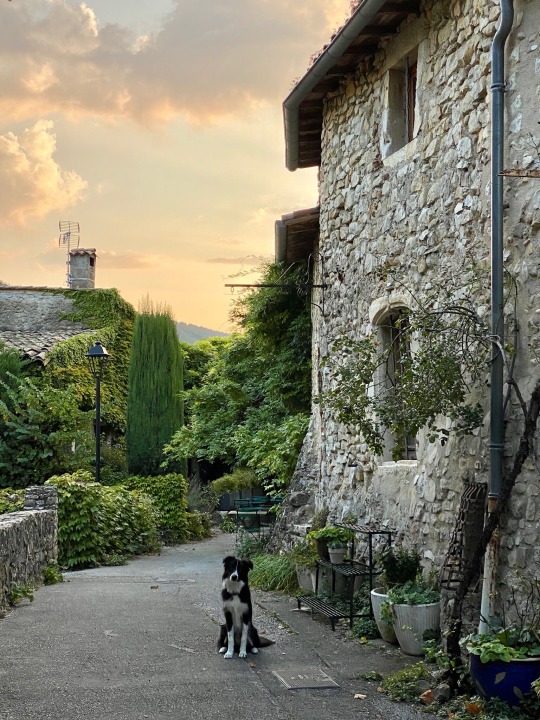
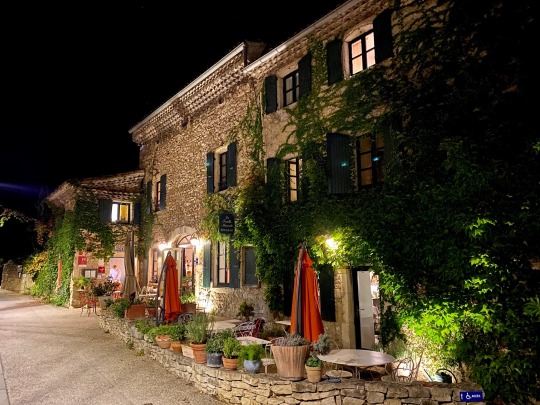
Both of these villages were pretty, but they were essentially stopovers on our way down to the ritzy Riviera. Before arriving in Nice though, we had one last town on our ‘rustic’ leg of the trip: Cassis.
Cassis is technically part of the Riviera, but being two hours east of the Big Three (Nice, Cannes, and Monaco), it attracts fewer visitors and therefore maintains some of its fishing village charm. It was still hot – nearly 85 – so we slowly shuffled through the town’s small alleys.
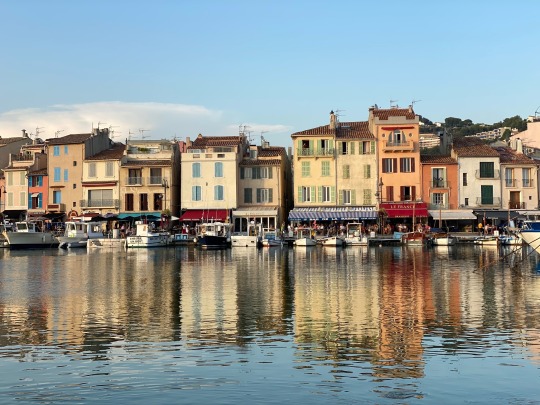
After lunch by the beach, we set out for Cassis’ main attraction: the nearby calanques. Calanques are narrow inlets along the Mediterranean, characterized by bright blue waters and steep surrounding limestone.

The prettiest calanque is only accessible through a 5 mile hike … so I felt terrible for Indy. A black dog, covered in fur, on an 85-degree day? Luckily there was a beach at the end to cool down.
The walk started easy enough: Indy darted from shade-to-shade, having no idea what he was in for. It was a simple walk in a picturesque Mediterranean setting: highlighter blue water ways and white chalk cliffs coated in bright green pine trees. We reached our first views of Calanque d’en-Vau hardly breaking a sweat.

…That’s when the terrain turned into Vertical Limit. Chelsay & I covered 90% of the distance in about 30 minutes, then last 10% took an hour. It was essentially straight down – so steep in spots that I had to carry Indy while trying to keep my own balance. Now I was dealing with his black fur in 85 degree heat! Were these rocks slippery or is it just sweat seeping through my socks and shoes?
We eventually made it to the beach – thank god. It was strange being on a pebbly beach (especially after Australia), but we were in the water so fast that it didn’t matter.
Once in, Indy put on a show for the rest of the beachgoers. This was the deepest Indy had ever swam. Sure, he fetched a stick from a pond before, but never really swam. He loved it though. Took to the water like a fish to… uh, water.
He’d paddle out 10m in random directions, chasing someone he thought might be Chelsay or I even though we were beside him. He looked like a crocodile with his head barely above water and long body slowly trailing behind.
A few times, Indy would sit upright, so his paddling created splashes. This caused a new excitement, and he’d try to bite the water coming from his own splashes. Chelsay and I could hear laughter coming from the beach.
youtube
The sweaty hike back to Cassis wrapped up this first phase of the EuRoad Trip. It provided exactly what we were hoping for (Beauty and the Beast settings).
After Loire Valley chateaus, provincial villages, World War II podcasts, and rustic French countryside experiences, Chelsay and I were ready to clean ourselves up for our next destination: the ritzy French & Italian Riviera.
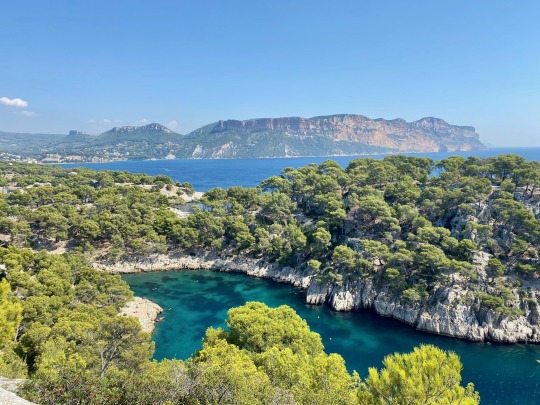
0 notes
Text
The Crazies



HAPPY 4th of JULY! It’s all hands on deck today (our choice). We decided we’d be available to help out today since it’s going to be wild. We have 23 departures today and 30 arrivals. Steve is already out working getting sites ready. I will go into the office around noon when arrivals should be starting to come in. I just hope we don’t have any issues. We found out the other day that a guy had called to extend his reservation by a day but it was never put on the reservation system, so his site wasn’t available for that extra day and he had to move to another site for a day. It wasn’t my fault, THIS time, but I would never put it past me to have done something similar. I really can’t express how crazy it can be in the office. I have tried but unless you witness it, you can’t believe that so much could be going on at one time. Steve witnessed it the other day and was in shock at how often the phone was ringing and the other things that were going on in the office at the same time. So, I mentioned the guy with the messed up reservation…he repaid us by stopping his trailer with his motorcycles on them in the middle of the road to unload them right at the time when several RV’s were trying to pull out and blocked traffic. Bill and Jen had to go up and direct traffic and send them around the tent area loop (which is NOT designed for RV traffic) because he refused to move to another location. So maybe this is your “where’s your sign” blog edition #2. (Well, that’s as far as I got on my blog work this morning…I got a text asking me if I could come to the office. Apparently, Jen had been on the phone non-stop for 2 hours and was about to have a break down. So, I had to go to work a bit earlier than I had planned…and it was pretty crazy even when I got there.)
Here are a few of the crazies we’ve had this season: We had a couple come into the park a while back who booked a site for 4 nights. They weren’t super happy about their site, but we weren’t able to put them in another site, so they paid the bill. They went to their site and then immediately pulled off saying they were hungry and going into town to get some lunch. They never returned. Later they called their credit card company and said they’d never stayed at the park and reversed the charges. (I didn’t realize it was that easy to get charges reversed on your card. There wasn’t even an investigation by the credit card company.) Jen is now having to provide video and other proof that they were here so they will be forced to pay the charges.
We also had a couple here that started having packages delivered to our campground even though they hadn’t arrived yet and wouldn’t for another week. 15+ packages were delivered. The lady said they were all RV parts because they were having issues with their RV. (Didn’t know Chewy’s sold RV parts!) Jen called the lady and told her she needed to come pick-up the packages up because we couldn’t hold anymore for her. She happened to be staying at a park nearby and she came to pick them up the next day. They finally arrived and continued to get packages. Time came for them to leave and they said they’d be getting a few more packages because they had wanted to stay at our campground longer, but we couldn’t accommodate them, so they had to go to another park. Not sure why she thought we’d be her mailbox. I think she wore out her forever welcome at this campground.
Speaking of crazy, we had some crazy weather last week. One day a storm just came up out of nowhere. Next thing we know it’s pouring and pouring. Then the hail started. Thankfully it was only pea sized but there were 2 rounds of it but it covered the ground like snow. The next day, they had to work (and Bill even hired someone) on the roads that were all washed out and the laundry room that flooded. Next day, the skies opened up and dumped more flooding rains and hail. This time there was some quarter sized hail. The weather report was saying golf ball sized so we were praying hard that that wouldn’t be the case. God heard our prayers and we didn’t sustain any damage.
We had to make another vet visit. I think we’re going to end up with veterinaries in every state by the time we quit RVing. Aspen was having trouble peeing and just like the little “person” he is, has a UTI. He is currently on medication and seems to be doing better. By the way, there’s a great vet clinic in Newcastle, WY called Salt Creek. They were extremely helpful when we were trying to decide it if was an emergency or not. We were very impressed by them.
Then the fridge is still acting up. We called in a tech today to come see what he could find. He agreed that Steve had tried about everything there was to try but he had one more thing he wanted Steve to try. We are supposed to give it a day or two to see what it will do. We may be looking at converting over to a residential fridge or buying a new and improved Amish-made cooling unit. Either way, we may be looking at a $2K investment. It may be worth it to have ice, cold milk again!
Our adventurous sides led us on another hike in Custer State Park this week. It was a perfect day albeit a bit windy. We hiked “Little Devil’s Tower.” It was a fun hike that had some unexpected turns. A section of it was narrow and we had to scramble up some rocks to access it. The last part of the hike was a lot of rock scrambling. Our hands were in pain after we finished where we pushed up against the granite rocks to shimmy up to the top. Steve said he felt like a mountain goat! We passed several families carrying small kids and walking dogs. We wondered how they were going to handle the climbs and narrow areas. It was definitely worth it though when you reached to top due to great views of Cathedral Spires and Black Elk Peak. It was extremely windy at the top and the temps dropped about 10 degrees. If you don’t mind climbing up and over rocks, I would highly recommend this hike. It was a 3-mile hike and took us a little less than 2 hours. (The photos on this blog are from our hike.)
I’ll close with a bison story. I’m not sure how to put this delicately but there was someone staying at Big Pine who went on the Wildlife Loop to view the bison. They got stopped in the road by a herd and one decided to “hump” the car. I’m not sure what the bison was thinking…how does a bison confuse a car for another bison? I didn’t see pictures of the car afterwards, but the bison damaged their car. What a story to tell!
0 notes
Text
Agilenano - News: Because your home is now your workplace, gym, coffee shop, and primary care facility, you’ll need to keep it in good working order.
Under normal circumstances, “honey-do” lists and “weekend warrior” projects often get pushed aside by the daily grind. But in this bizarre new pandemic reality, that grind has ground to a halt. If there’s an upside, it’s that you have both time and incentive to knock out some of those around-the-house chores you may have put off. We spoke to a project manager and lead carpenter with a home remodeling business to find out what projects anyone can do to keep their homes in tip-top shape. And don’t worry if DYI isn’t your thing. Not only are these 11 tips easy for most anyone, but we even included a simple list of beginner tools to help build an essential toolkit you can be proud of. 11 Easy & Essential Home Maintenance Projects We spoke with John Wagner, a partner and project manager at the Twin Cities-based Waxwing Woodworking Inc. He identified 11 projects every homeowner should do to keep their house running efficiently and safely. And if you’re a renter, you can still check these things and let your landlord know. And while Wagner said you could easily get all these done during these social distancing mandates — some take as little as 30 seconds — at the very least, you could use this time to check all the items and make a plan for the next couple months. 1. Change your home air filter Filters should be changed monthly, and you should always have a spare one on hand. If you don’t, check the filter size and head on down to your friendly neighborhood filter (hardware/home improvement) store and pick up a bulk pack. Unless you have acute sensitivities to specific particulates, a filter with a “MERV” rating of 5 to 8 will be fine. A higher MERV rating will trap finer particles, but at some cost to the efficiency of your furnace. If you’re not sure what filter to use with your system, check the service manual or give a local heating contractor a call. Once you have the new filter, remove the old one and replace it, taking care to orient the filter for the direction of airflow. If you don’t have the size of the filter and direction of airflow written on your filter cover, now’s a good time to bust out the marker and get that done. 2. Clean gutters, check downspouts Take a walk around the perimeter of your house and check your gutters and downspouts. If you didn’t clean your gutters after the leaves fell last year, get to work. But don’t just leave that crap on the ground! (More on that later.) Downspouts should extend a minimum of 5 feet from the foundation to keep water from working its way into your basement. If you have a finished basement, a nice, long downspout could wind up saving you a ton of money. Most basement moisture problems arise from bulk water intrusion caused by bad slope and drainage. If your soil doesn’t slope away from your house (6 inches over 10 feet), that’s a major issue to address. Quick note: If you live in a cold climate, you should have a dehumidifier running from spring through fall (especially if you have a finished basement). 3. Prep garden, remove yard matter near your house Once you’ve thrown all your gutter goo onto the ground, pick it up. Rake up the old, decaying stuff from around the house so that soil isn’t building up against the house. If you put mulch around the house, it’s good to maintain 6 inches of clearance below the siding, especially if your siding material is a wood or wood composite. Personally, I like a 12- to 18-inch bed of crushed rock or gravel between the foundation and plants. That buffer will help prevent moisture and pests from working into the house. Plus, this is also a great time to plan for your vegetable garden. If the soil has thawed enough where you are, mix in some compost, and you’ll be ready to plant when the weather allows. Finally, now’s a great time for tree trimming. If you’re up to it and can do it safely, trim away dead or decaying branches and manage the growth of fruit trees. The University of Minnesota Extension has excellent resources for managing trees and gardening. 4. Clean air-conditioning coils First, you’ll want to clear away any plant growth around the condenser. Hook up your hose and decide how clean you want the condenser. You can either take the cover off (be sure to flip the breaker off inside) and clean from the inside out, or you can spray from the outside with the cover still on. Either way, spray at a downward angle until clean. If you’ve removed the cover to clean, you should be really proud of yourself — unless you damage the thin aluminum fins by folding them over. 5. Vacuum refrigerator coils Carefully walk out your refrigerator and start suckin’! Pull off the cover on the front that overlaps the wheels and vacuum that out. At the back of the fridge, vacuum the coils and motor. (No need to look behind the fridge, there’s definitely nothing there. Nope.) Just slide the fridge back. Be sure the fridge has an inch or so of clearance above it to allow warm air to escape. 6. Check siding for holes or other entrances for vermin, seal them If you had any winter guests this year, now’s a good time to check around the house to see how they got in. Start by following #3 above. Then, check for holes in the siding, gaps below the last course of siding (could be loose bricks or cracked stucco), or gaps that might have formed in your soffits. You can fix most means of ingress with better landscaping, steel wool, a good-quality caulk, or spray foam. Now, if you had squirrels or raccoons get into your attic through holes in your soffit or fascia, you might want to call a contractor. 7. Summerize snowblower, prep lawnmower for season If you’re not expecting more snow, get your snowblower ready to hibernate. Remove the fuel that’s in it and empty the fuel into a safe storage container (you can dump the fuel from the snowblower into your gas can). Don’t be a jerk neighbor and run your snowblower for 2 hours to burn off the fuel. Also, get some fuel stabilizer and pour that into your gas can before filling it up with gas. Next, clean up your snowblower. Lubricate any parts that move, pull the spark plug, and get a bit of oil worked through the motor by pulling the cord a couple of times. You might as well check to see if your augur blade is worn down or damaged; the same goes for the scraper blade. As for the lawnmower, if it ran well the year before, you should be able to fuel it up and get it going. If not, it’s generally a simple procedure to pull and clean the carburetor, replace the spark plug, and complete an oil change. Now, if you’re feeling frisky, you can check and sharpen the mower blade. Disconnect the spark plug, flip the mower, and remove the blade (you’ll need a wrench). Clamp the blade in a vise or clamp it to a sturdy table. With an angle grinder and a sanding pad, give the blade a few passes at a 30-degree angle. If you’re left with a rough burr on the back side of the edge, knock it off with a few passes of a file. If you don’t have an angle grinder, you can use a sharpening stone or a file, but it takes much longer. 8. Check washing machine filter, clean dryer vent This one is pretty straightforward. First, check your washer’s manual on how to clean the filter. It will probably say something smug, like, “Clean this filter monthly.” But there’s another inlet filter that’s also super easy to clean. Turn off the water supply, disconnect the hose, and remove any particulates. This is an especially important task if you have older, galvanized supply lines in your home. Cleaning the dryer vent is super important, too. First of all, your vent should be a rigid pipe, and the joints should be lapped so that lint isn’t accumulating at the edges. Disconnect the pipe from the dryer (just pull, and you might have to cut some tape) and check the vent on the dryer. Clear or dirty? Any toys in there? Next, take a look into the pipe. Slide a vacuum hose up there with a brush attachment. Now, head outside to the dryer’s exhaust port. On the outside of the house, check to see if the damper closes smoothly or if lint has accumulated there and was letting freezing-cold air into your house all winter. Clean it. Reattach the pipe and re-tape those joints with a quality foil tape. If you have a flexible vent pipe, switch to a rigid pipe. Rigid pipe will vent more efficiently, trap less lint, and is overall safer. 9. Check carbon monoxide and smoke detectors Test ‘em all! Change the batteries. If any of the units are old, replace them. Many new units come with sealed batteries and are good for 10 years. You should have a minimum of one smoke and one carbon monoxide (CO) detector on each floor, a smoke detector inside and outside of each bedroom, and a CO detector within 10 feet of each bedroom and sleeping area. 10. Upgrade your thermostat Get and install a smart thermostat. Personally, I like the ecobee. Chances are that your energy provider offers some kind of rebate, which will offset some of the initial cost. It proved super easy to install in my home, even though I didn’t have a C-wire. The savings started immediately, the unit is super intuitive and functional, it looks nice, and the sensors prioritize heating and cooling occupied spaces. Why do it? Because a super-easy way to save money and energy, as well as limit emissions, is to not be such an energy hog. Sign up for off-peak energy and adjust your thermostat settings so that your house is 65 degrees in the winter and 76 degrees in the summer. Some people may require different temps for health reasons, but your house doesn’t have to be 70 degrees all year ’round. 11. Check water heater The more adventurous among you may want to try a little water heater maintenance. Three things to do here: Check the pressure relief valve, check/replace the sacrificial anode, and flush the water heater. Testing the pressure relief valve will get a bit of scalding-hot water on the floor. So wear sturdy shoes. This one is better to watch — I recommend the trove of good info on the This Old House channel on YouTube. This is really a show, don’t tell fix. Check out some of the channel’s videos below. Temperature and pressure relief valve: Sacrificial anode: Flush water heater: Bonus: Start a home savings account The best way to save money is to actively save money. So if you have the luxury right now, you could start a savings account for your home. A good rule of thumb is to save 1.5-2% of your home’s value every year. If some of the systems in the house aren’t in great shape or are older, save a little more. For some perspective, a full replacement of a forced-air furnace and AC condenser can easily run up to $10,000 or more. Basic Toolkit for Home Maintenance To tackle most home improvement projects, you’ll need some rudimentary tools. Here’s a list of tools you should have on hand to tackle common DIY tasks: Home DIY Toolkit Hammer Phillips, flathead, or interchangeable-head screwdrivers Electric drill with bit kit and driver bits Tape measure Utility knife Pliers Adjustable wrench Small handsaw Voltage detector Wire nuts Wire cutters Safety glasses and ear protection Level (32″) Electrical, Teflon, duct, and painter’s tape Allen keys Small socket set Small pry bar Rags Pencils, sharpies The post 11 Simple Home Projects to Bang Out During Quarantine appeared first on GearJunkie. #Coronavirus #Lifestyle

Agilenano - News from Agilenano from shopsnetwork (4 sites) https://agilenano.com/blogs/news/because-your-home-is-now-your-workplace-gym-coffee-shop-and-primary-care-facility-you-ll-need-to-keep-it-in-good-working-order-1
0 notes
Text
Can ONE Exhaust Fan Make a Difference? Read This Must

I am kind of doing this impromptu because I received more than a few comments about the lack of an exhaust fan in the P 400 A and how my conclusions were somehow skewed because I didn't include another fan. I just use the fans that came with the case that were installed out of the box. Do you guys know why I do that? I test things out of the box because that's how most people tend to leave things. I don't expect all of you to have extra fans laying around. You can pull from build to build, although that would be ideal. I just don't like to leave those people out. So I stressed in that video. This was going to be more of a worst-case scenario because first off, we're using the white version, which is going to reduce the porosity of the front panel, but also that we were using just the three fans because 3 fans are typically enough for most cases out there. I'd say at least most mid towers 3 fans should be enough. I left them in the stock config because I figured. Fantex knew what they were doing. If you have a porous front panel, they're gonna put as many fans up there as you can because you can get more air into the case and whether or not it's a negative or a positive pressure differential between the case and atmosphere.
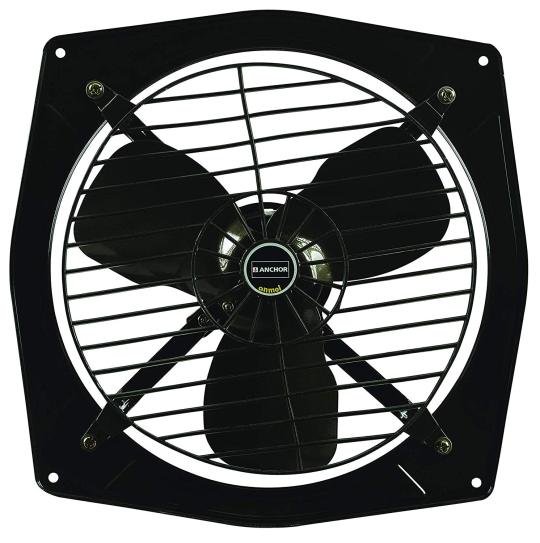
I think that that's more or less irrelevant. A lot of people who do this case, testing for living between people at work and in Vidya, HMD and elsewhere will tell you that the pros and cons of positive and negative pressure really kind of the kind of balance each other out, whether you're doing one or the other. As long as you have some movement of air in and out of the case, that's what you should be going for. And you guys were hinting at a few of you were hinting at how including an exhaust fan would speed up that air removal process, get rid of some of that heat in lower c_p_u_ temps, possibly even gravid. Scrafton's I'm not sure how a single exhaust fan at the rear. Next to the c_p_u_ cooler is going to affect graphics for temps. We'll find out in this video. The whole point is to learn something. So we're gonna see if one exhaust fan can make a heck of a difference because that's what some of you seem to think. So we'll see. If you're rocking the Windows 10 operating system and haven't activated your copy, click the link below and purchase an OEM license from the SCD key, then click here, here, here and then pastry activation key and you'll have a fully activated OS in seconds. And be sure to use my office code as a studio for an 18 percent discount on your order. So we will need to rebuild our entire system in this case. That's OK. Part of the job, not a big deal. Some of you were complaining about the fact that I was using the stock vans. That's not going to change. I'm not going to swap these fans for knocked with fans. Not going to happen. You can go to other channels for that stuff. I'm going to test what comes in the box. And I might add to that just to play around with it like we're gonna do in this video, but I'm not going to swap these out entirely. Some of you are saying that these fans weren't ideal for pulling air through. If that's the case, that's Fantex fault. And I'm still going to conclude the way that I concluded the original review. We did also test the viability of the mesh by completely masking it off and allowing air to be pulled in from the top and bottom, as was the case in traditional P 400 and concluded that the mesh itself was not very effective at allowing air to pass through it. So I'm not sold on the idea that replacing these fans will magically make the mesh any more porous. That's why I ran the tests that I did in that video. So these fans are going to stay here. There's my justification for that. The only variable in this video is going to be that single exhaust fan. We're just gonna see help make a difference that one fan makes for temperatures on both our c_p_u_ and graphics card. Yeah. All right. Let's build and then I will show in real-time. The tests will try to replicate our results from the review video first and then we'll throw that one fan in there and see how things change. I would try a cool jump getting ready for this. Three, two, one. All right. Now is probably really cheesy, but I was like 20 minutes of work. It's pretty straightforward. All right now. Coming up on 30 minutes for this test, I kept the monitor pretty far away from the case, too. I don't want the heat from the monitor to affect temperatures here. We want to keep this isolated. I've made sure Pepsi is not messing with anything. Pepsi. So you're not messing with anything, right? All right, so let's stop this test and we are going to put up here two statistics and look at that core five eighty-five degrees. That's exactly what we found last time. And GPE diodes 77 degrees. Let's see, I have my phone here to double-check and remember exactly what graphics card temps were. As long as we're within 1°c Celsius of yesterday's temperatures will be OK. P 400 a panel on eighty-five. Seventy-seven. OK, cool. So exactly what we got yesterday on this test. So if you were doubting my results from yesterday, you'd see it in real-time here. By the way, all of our fans are running at a 50 percent fan curve. The reason why I use 50 percent and I don't set it to an hour p.m. specifically is because every case fan is different. So every fan is Pepsi. What are you doing? Hey, what do you what are you doing? What are you doing? Anyway, every case Fanis designed to run at a different hour PM. If you buy certain fans that are meant to run quietly, they're probably going to have a lower operating our PM. And that's just because the slower the fan rotates, typically the choir at a quieter it is. So I set a fan curve for all of our case tests to 50 percent on the motherboard. So no matter what fan I plug into it, whether be voltage or p.w im, those fans are set to run 50 percent max load. This is fair in my eyes because if you throw a 200mm fan in here, right, those fans are going to Patsy. Those fans are going to turn much slower than 120mm fans because they know how to turn fast to move the same amount of air. So 50 percent of that fan curve that Max Arpey on might be 400 or p_m_. Right. Whereas these fans might be operating closer to a thousand. I think they're operating at like 950 at a 50 percent curve. So that's why it's not going to be the same. Our p_m_ for every fan. And that's just because some fans are designed to run slower than others. I'm not going to fault or give an advantage to any stock fan. They're all gonna run at the same percentage of their full curve, their full potential. The exhaust fan we're gonna be using is the Kromaggs in October and F F 12 p.w M at 120mm fan. It is a black fan, unlike some of not was frankly ugly or brown ones, which is nice. That's why they call it Kromaggs. Or some other reason I've called Max is that you can swap these out. Black looks good with really any background color you have. Yellow, blue, green, red, white and black rubber vibration mounts that you can install pretty easily on these fan frames and you can effectively change the color and theme of the fan to match your build. So another perk of the Kromaggs fans is also going to run fairly quiet because it is an octave event. After all, I've linked one of these down below, if you're interested. Not with something a long time ago for builds and whatnot, and I haven't taken the time to showcase one of these four guys. So this is what we're gonna use, 50 percent fan curve. The operating our p.m. is like 50 hundred p.m. so take that into account for a PIN again and the acoustic noise twenty-two points four d.E.A. OK. All right. Let's throw this into the system. All right. And we've just crossed the 30-minute threshold. I can see things have leveled out. They may live it up quite a while ago. And that's indicative of their cool build, right? You can saturate a smaller c_p_u_ cooler fairly fast, whereas if you're using an AoE or something that involved water, then you would have to let this run for. I would say at least 30 minutes it probably longer than that in some cases, depending on how big the loop is because it takes a lot more energy to heat water, a unit of water, a certain amount of water by one degree Celsius. So this is just for good measure, right? Running at this long, we're gonna click stop and we're going to check these stats again. And the hottest core again was score five. Eighty-five degrees Celsius. Now, this is interesting. So I didn't expect this at all. This is weird. The GP diode, that's just the diode in the GPO itself to measure temps 74 degrees Celsius. That is, if I recall correctly, a three degrees Celsius drop from the non-exhaust fan run. So it's probably happening as the exhaust fan is pulling out more of the air than would be the case if we didn't have an exhaust fan that allows the internals of this case to run at a slightly lower pressure than stock. So we were running at a fairly positive pressure, to begin with. This kind of reduces the differential between the atmosphere and the internals of the case. And that probably allows the graphics card to pull more air into the shroud from behind. Right. So there's more pressure inside the case and there is an atmosphere. It's going to be harder for the graphics card to pull even more air inside the case because remember, no pressure flows from high to low. Right. So we're areas of high pressure exists that wants to escape. It wants to go up that vent the atmosphere. And so that's counteracting the pull of the graphics card, trying to get that fresh air in from the back, which is what we saw with the H. 500. Right.
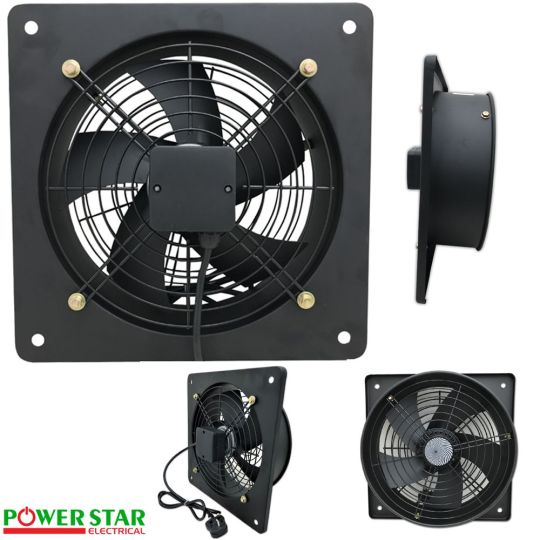
That's why graphics card temps and H 500 were a lot better than we expected, despite not having a fan up front giving the card fresh air because we were running a negative setup. In that case, the graphics card had no issues pulling fresh air in from the back. Interesting results here. So now what I've done just for one more test because I feel like while we're at it, we might as well try a few other things. I'm going to max out the fan curve for the exhaust fan. So now you can see remember on the box that it was around fifteen hundred are ppm plus or minus 10 percent. So right now at full speed, we're at about fourteen hundred little over fourteen hundred our ppm for that exhaust fan. It will remain this speed for the duration of the test. And now we are going to see if the c_p_u_ can drop by even one degree Celsius. And coming up on 30 minutes, one last time here, we're gonna hit stop. Statistics.
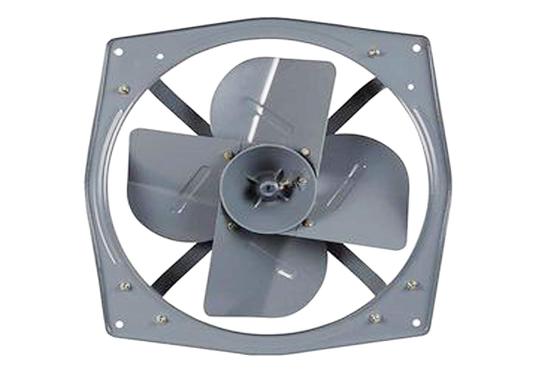
And look there finally our hardest core, core 5 has dropped by four degrees from eighty-five to eighty-one. So we could conclude a few different things from these tests. First up, I don't want you guys to generalize us too much because we only tested one case. Every case is going to have its unique airflow characteristics. I will say, though, that we can kind of generalize this, at least for mid towers with somewhat restricted front panels. And in situations where we have three fans that are trying to pull air through a restricted panel, I think this is where this would apply to most adding an exhaust fan and benefit the graphics card for reasons we explained a bit earlier. As for the c_p_u_, we saw no temperature change at all when the fan was running at 50 percent of its max are p_m_. If you do decide to run that fan at 100 percent of our p.m. for the entire gaming session or whatever workload session you're running, then sure your CPO will benefit from that. My point is you won't see those gains until you set that fan to some unrealistic curve. I would not advise anyone to go out and just by default set your fan curve to 100 percent for the entire load. That to me is just it's not realistic and you don't need to do that. Your S.P. is gonna be just fine running two or three degrees hotter assuming you're not already at T-junction and assuming you're not being Thorold thermal throttle. So. I mean, the graphics card sure benefited by, what, 3 degrees? I'll give you that that's a noteworthy decrease in temperature just by hitting an exhaust fan. You would think at first that it would affect that. I was kind of surprised at first, but I think it makes sense the more we look into it. But yeah, the c_p_u_, I mean you've got to turn this fan up to get it to pull more heat from the c_p_u_ cooler. We've already got a sequel or fan effectively exhausting air like it's pushing air through the exhaust vents in the case. So adding a second fan there is just going to speed that process a bit more. But you're only going to see those results again when the fan is turned up. So I'm not willing to outright say that an exhaust fan will radically change anything about the tests that we run. Having an exhaust fan is good. It's a good practice, even if it's a cheap fan, assuming it's not going to run super loud again around a 50 percent curve. That's just what I use. Other viewers might use 40 percent, 80 percent. Heck, they might set a specific APM for every fan and that's fine. They can justify how they want. I feel like I've justified mine enough in this video, but I'm willing to say that yeah, exhaust fans. I'm not going to throw into every case. If manufacturers choose to throw one up there, that's fine. I'm still content on testing cases. Exactly how they come out of the box. Someone said, well, what if a case doesn't come with any fans? Well, in that case, what I would do is include two or three fans would probably only be two, and then I would add the price of those fans to the price of the case. Not gonna be expensive fans, but I expect that people who buy this case will also have to buy fans. So if you're not going to include fans out of the box, then I'm going to add that to the price or my overall outlook of that case. So that's how I do it. Everyone's getting the stuff differently, but at least we learned something. I learned something. I didn't know that adding an exhaust fan would change graphics attempts more than c_p_u_ terms at a lower curve. So that's interesting because I enjoyed this one. but now we'll catch you in the next one. This is E-News Gear. Thanks for learning with us. Read More: Tesla Cybertruck first ride: inside the electric pickup 2019 November Read the full article
#bathexhaustfan#bathroomexhaustfan#bathroomfan#dirtyexhaustfan#diyexhaustfan#exhaust#exhaustfan#exhaustfanbathroom#exhaustfaninstall#exhaustfannoise#exhaustfanrestoration#exhaustfansekai#exhaustfantimer#fan#fanexhaust#installexhaustfan#maxxairexhaustfan#oneexhaustfan#replaceexhaustfan#roofexhaustfan#shopexhaustfan#shutterexhaustfan#vintageexhaustfan#wallexhaustfan
0 notes
Text
A Houseboat Vacation, Voyager’s National Park, 5/23/19 – 5/27/19
Over the years, our family has done vacations via car, airliner, RV, train and passenger van. We’ve stayed at 5-Star Resorts, hotels bordering on 0-Stars, rental homes and under the stars in a tent. What they all have in common is that they all involved some kind of adventure. Not wanting to duplicate any trip we’ve ever done, we decided to embark on a HOUSEBOAT ADVENTURE with Dyan’s family into Voyager’s National Park in the Boundary Waters, one of the most remote and beautiful areas of the country.
Situated along the Minnesota – Canadian border, Voyager’s is mainly made up of three large lakes: Rainy Lake, Lake Kabetogama and Namakan Lake.
This place is a true fisherman’s paradise. Comprising nearly 300,000 acres, you could spend a week on a remote island and never see another boat. The pristine, unpressured water can result in trophy walleye, musky, northern pike and tough fighting smallmouth bass. Needless to say, when Dyan mentioned the idea of a trip here, I was ALL IN.
Joining us on the trip were Mike, Rachel, Madison and Morgan as well as Dean and Deb. Voyager’s is Dean’s old stomping grounds. Before the national park was created in 1979, Dean’s dad had a cabin on Kubel Island. Dean would bring Dyan, Rachel and Amanda up to the cabin on memorable summer vacations when the girls were little. After Dean’s dad passed, the property was ceded to the National Park. Dean still makes annual trips to the area, and is an expert navigator of the park’s waterways. One of the great things about having Dean with us is that he knows where to go, and where to stay away from. He also claimed that the big smallmouth couldn’t resist a green Mepps in-line spinnerbait…we’d see about that.
5/23/19
At 7AM, we were on the road heading north, a caravan so-to-speak.

We had four trucks and two boats (the Blaniels needed both our rides in order to fit all seven of us + the boat + our stuff).

We made a quick stop in Ham Lake for breakfast, another in Cloquet for gas, and a final in Orr for some lunch and bait. We made great time rolling into Ebel’s Voyager Houseboats on the Ash River Trail at 1PM.

First order of business was unloading all our gear into the houseboat and launching the bass boats.

Promptly at 2PM, we broke away from the dock and headed north up the Ash River.

The river is too narrow to pull the boats behind the houseboat, so Mike and I cruised out ahead of the mothership until we reached Sullivan Bay. This was the first time I really had a stretch to open the new Mercury motor up. I stepped on the gas and ripped across the lake, with no regard to what was going on inside my boat. In my excitement to hit 60mph, I never secured the container of nightcrawlers that ‘had’ been sitting on the bow of the boat by the trolling motor. I say ‘had’ because they were no longer on the bow of the boat. The container got picked up in the onslaught of wind and the entire contents spilled out all over my brand new boat. I had worms and soggy dirt everywhere (to go along with my trolling motor oil). This boat was a disaster. As I was cleaning up my boat in the middle of the channel, Mike and Aidan were busy casting a rocky looking shoreline, and picked up 3 pike in less than 10 minutes!

When Dean caught up to us, Mike and I tied off the Nitros and let them dangle off the back of the houseboat, side by side.

We putzed to the east for about three hours before reaching the east side of McManus Island, our first campsite of the weekend.

Just before arriving, Mike and I took the Nitros up to the island and scouted out the deepest part on the beach for which to beach the houseboat. Once we radioed in the correct line, Dean flawlessly pulled the houseboat right up on shore. Mike and I tied off the houseboat at 45 degree angles and drew the plank from the bow onto the sandy beach. In moments, the kids swarmed like gnats at a BBQ. The kids were everywhere. In the woods, out of the woods, in the water, out of the water, in the boat and out of the boat. We scavenged the island for wood to throw in our sputtering campfire. All the wood was waterlogged from our record wet spring, so getting the fire going was a challenge.

As the kids explored the island, and the girls prepared Dyan’s homemade lasagna dinner, Mike and I headed out for a couple of hours of fishing. It was chilly, with temps only in the low 50’s, Mike had better luck than I as he hooked into a couple of smallmouth as we tried shallow and deep around the Wolfpack Islands. In the spirit of some friendly competition, Mike made sure to get my boat in the background of his fish picture. This picture was the closest my boat would get to a fish that day.

Back at the campsite, birthday cupcakes were being consumed as the girls celebrated Madison’s birthday.

That evening, we hung out around the campfire as the sun lit up the tree tops across the bay…it looked, and felt almost fall-like.

As it got darker, I made a quick walk to the other side of the island and caught this pretty sunset.

5/24/19
I was up early, around 5:45. I looked out the window. Mike had already taken off in search of a honey hole. I quickly got dressed and headed out to the boat. What a glorious morning.

I headed around the north tip of Sheen Island and fished the channel to the west of Sheen and McManus. I was marking fish in 20FOW, but didn’t know what species they were, or what they would bite on. I tried the jerkbait, crankbait, spinnerbait, dropshot and shakeyhead. Nothing. After an hour of fishing, Mike pulled up beside me and I told him I had a spot I wanted to try. It was a barely visible rock pile in the middle of Randolph Bay. We both buzzed over to the spot. Mike fished the north side of the rocks, I fished the south side. Immediately, Mike got bit on his first two casts, and then got a third bigger fish a short while later.

Both of us were using deep running jerkbaits, but I could not seem to get bit. At 8, we headed back to the houseboat for some breakfast.
The kids were getting a bit restless, they wanted some excitement. As we pushed off the island in route to our next campsite, the girls came with me for a boat ride while Aidan went with Mike for some fishing. We blazed across the lake in the chilly damp air as the girls laid across the casting deck and shrieked with enjoyment.

We couldn’t hit waves big enough for them. We couldn’t go fast enough for them. We couldn’t stay out long enough for them! They were having a ball. About the time we were heading in to tie up to the mothership, Brianna got hooked up with my crankbait. That’s the biggest and best thing I would catch all weekend!

The morning cruise to the Pike Bay campground was much shorter, maybe 90 minutes. Dean captained the houseboat perfectly as he navigated the often tricky waters. He’d probably say it was a piece of cake, but after looking at the dings on the bottom of my boat after the weekend, it absolutely was no cakewalk.

After the houseboat was tied off on the beach, first order of business was a fire, and some exploring. The girls hiked into the woods in search of birch bark for the fire. Aidan chopped wood with the axe.

After only one day, we were a well oiled machine in terms of gathering wood and getting the fire going. Well, most of us were a well-oiled machine. Nice work or retrieving some birch bark ladies...

After lunch, the rain started coming down. Aidan and I went fishing in an unnamed area southeast of Juniper Island. The bite finally turned on for me. Using a jerkbait, I picked up 3 species of fish in less than an hour. My first fish was a 20” northern pike. The second fish was a 15” walleye. And finally, my third fish was exactly what I had been hunting for – a chunky smallmouth bass. mike also caught a couple more smallies.

We saved the walleye in the livewell in case we caught a few more to fillet up.

Later that afternoon, we played a kid-friendly version of Farkle and the kids tried out the teenie weenie hot tub on the roof of the houseboat. They loved it!

While everybody was busy having a good time, Mike and I snuck out on his boat for a little more fishing in the rain. Once again, we headed over to the same area we had fished earlier in the day. Our focus was on isolated rocks or rocky points. Mike and I were both throwing jerkbaits. We caught 2-3 fish on every spot we stopped at. It was actually pretty comical with the amount of smallmouth flying through the air as we flipped them into the boat. I stopped keeping track around a dozen fish, but it would not surprise me if we hauled in 30+ smallies in the few hours we were out. Only one of the fish we had on was a true giant (guessing 5+ pounds?), but Mike lost that one right at the boat. Mike also reeled in another keeper walleye which we knew Aidan would want to eat, so that one went into the livewell. Also in the livewell were our biggest smallies of the evening which we kept so that we could get some pictures back at camp.


The funniest fishing story of the afternoon happened right next to the houseboat. As Mike and I were wrapping up fishing, for the evening, we both made a final cast. Mike had a fish slam his jerk bait. Just as quick as it slammed the jerk bait, his line snapped. The fish was gone. He was not happy. It was his last deep running jerk bait he brought with him, and that was the only bait that was constantly landing fish. As I was retrieving my lure to finish the evening, I snagged a fishing line. At first I quizzically looked at the line wondering whose line I caught, then realized, it was probably Mike’s. I started pulling on the line and hand reeled in his Northern Pike. Mike had his lure back!

We had baked mac & cheese for dinner before settling in at the dining room table to recap the fishing stories with the rest of the adults. We also began the lengthy process of getting everybody’s phone accessible for airdropping pictures. This ended up being a fun way to share everybody’s pictures from the day.
5/25/19
Today was our longest houseboat ride of the trip, so morning fishing was cut a bit short, which was fine. The fish weren’t biting other than a couple of small pike. After returning to camp and having breakfast, Mike, Aidan and Madison filleted up our couple of walleyes much to Aidan’s pleasure! He was so excited for walleye dinner!

By 8AM, we were pushing off the beach and heading to our next campsite in Mica Bay. During the boat ride, kids watched movies on iPads, colored at the table and helped Puppa steer the boat.

We arrived in Mica at 11AM and on cue, the sun broke through the clouds for the first time of the weekend. It felt glorious.

The beach was awesome, so we promptly built up a fire as the kids explored and gathered birch.

The girls even found time to create hand’s free cup holders for their next boat ride.

We had some delicious venison sloppy joes for lunch before all boarding on the Nitros and heading to Kettle Falls, the junction of Namakan Lake and Rainy Lake. Kettle Falls is one of the few unique places in the United States that you can look south and see Canada.

Popular with loggers, and fur traders in days past, the Kettle Falls Hotel still remains as the national park’s only full service lodging catering mainly to anglers today.

The bar is as unique as they come with a slanted floor the kid’s loved as they danced to old saloon music bellowing from the classic jukebox.

We spent some time touring the property and the Kettle Falls Dam before heading back to the marina and getting ice cream at the outpost.

As the kids enjoyed their ice cream on the dock, Mike and I raided the outpost looking for deep running jerkbaits. I snagged a couple at $17/lure but Mike damn near bought out the store. He invested so much money in the store it became a running joke that he was now part owner of the outpost.
After returning to the houseboat and dropping off the kids, Mike and Dean and I took the Nitros out fishing. We caught nothing in the beautiful afternoon sun. However, at one point, I one of my boat bumpers flew out of the boat. I circled around to retrieve the bumper when I noticed a school of giant fish on my graph in about 20 FOW. I had no idea what they were, but they were big marks. I quickly decided to fish instead of retrieving the bumper. I’d keep an eye on it and retrieve it after I had fished the spot. I hit spot lock on the trolling motor. I dug in my rod locker and found a drop shot setup. The weight on the drop shot was tangled a bit with my other rods so it took some time to get it sorted out. By the time I was ready to fish, they were no longer on my graph. To make matters worse, the bumper had drifted at least a hundred yards away and was now skirting the shoreline of a rocky island. I motored in close to the island. It was treacherous with giant boulders just under the water’s surface. I banged the skeg on the lower unit a couple of times…. hope I don’t put any holes in the bottom of the boat. I did get close enough to net the bumper and safely get away from the island. However, that was when Mike hopped on the radio and asked something to the tune of whether I had a Canadian fishing license. In my quest to get the bumper, I had crossed into Canada and was currently an illegal alien. I promptly crossed back into the Minnesota and looked for a more legal fishing location.
While we didn’t catch any fish that afternoon, we did make a trip to the house of Dean’s long-time family friends, Skully and Sandy. They own a home on Kubel Island. Dean’s Dad used to live in the cabin next door to Skully and Sandy. The friendships run deep, the alcohol runs freely, and the colorful stories Skully cooks up run from one to the next, not knowing where one stops and the next begins. After a couple beers with Skully and Sandy, we headed back to camp for dinner and a boat ride with the kids.

After dinner, we did some more fishing, working entirely around Mica Island. I got bit right off the bat using a square bill crankbait around fallen timber. I picked up the first three fish of the evening, the largest being about 2.5lbs. As we approached a tree, I called it out for Aidan, telling him to cast that tree until he got a bite. On Aidan’s first cast, he turned the reel one time before yelling out, “I got one!” I turned around to see Aidan line pulling around to the back side of the boat. This fish was a fighter! The fish thrashed around in the water and Aidan perfectly pulled him up next to the boat. I reached into the 47 degree water and plucked the brown fish out. Aidan had his first smallmouth bass ever!

We continued around the island picking up two more small smallies. At one point I got snagged on a rock. Trying to keep a safe distance from the shallow rocky area, I tried my best to position the boat and pop the lure off the rock with one hand. On one of those pops, my St Croix rod slipped from my hand and dove into the lake. Horrified, I quickly started fishing for the rod in the water and fortunately was able to save the $200 rod. Whew! In the 10 seconds of chaos, my lure had popped off the rock, so I guess it was my lucky day. But that was a good place to end the night. We headed back to camp, with Mike and Dean trailing just behind.

Once we rendezvoused back at the houseboat, Dean showed everybody his big fish for the night! Holy cow, that thing looks like a football!

At 4.5 pounds, that giant would be the biggest fish on the weekend. And guess what, he caught it using a green Mepps inline spinner bait, exactly what he recommended earlier in the trip. Damn, I should have listened to him earlier. Next time I come, I guarantee you I will either have one in my tacklebox or I’ll buy one at Mike’s Bait and Tackle Outpost! That night, we airdropped, had a few beverages and called it an early evening.
5/26/19
We were up early, and on the water fishing by 6AM. We fished the current down near Kettle Falls. At our first stop, I picked up a pike and a couple of smallmouth in the first 10 minutes, but after that, fishing shut down for Aidan and I. Fishing was slow for Mike too, as he had this two pounder to show for his efforts.

Around 9AM, we were on our way to our final and best campsite of the weekend, Kubel Island. Specifically, right in front of the former site where Dean’s family vacation cabin used to sit. Unmarked on any map, this site sits on a wooded rocky shoreline, going unnoticed by boats passing by. It isn’t a recognized park campsite, nor ideal for a houseboat - which is all the better because it’s unassuming location means most anglers, and tourist don’t even know it’s there.
This site was almost perfect for us… except, the shallow bay meant the houseboat beached about 10 feet further from the shoreline than the plank would stretch. Dean took a second run at the shoreline, trying to drive the houseboat as close to the shore as possible. The result was the same. We pulled the walking plank out from the houseboat. It was still about 10 feet short. I could tell Dean was having second thoughts about staying here if everybody could not get to sand without having to walk about 10 feet in the water. But this is where we needed to stay. This is kind of like a home away from home for Dean. I suggested we build a walkway from the plank, to the beach. The idea got mixed reviews at first, but after Mike and I started to build the foundation for the walkway by moving some heavy rocks, the idea started to gain a little traction with everybody. For about 30 minutes, we moved boulders and built up the base of the walkway. I suggested we build the walkway out with some wood, and Dean thought Skully probably had something we could use. Mike and I made the quick run next door to Skully’s and acquired a couple 4”x4”x8’ posts. We layed the posts on top of the rock foundation and our plank was ready to roll!
The kids spread out collecting birch bark while exploring.

Mike, Dean and I built a raging fire. Easily, the best fire of the weekend.

The kids spent hours playing on the beach and the wooded pathways between the Dean’s site and Skully’s house. Dean told stories of where the cabin use to be and where the kids played on the beach. This place holds a lot of special memories for the Daniels Clan.

While the girls spent time at Skully’s exploring the exposed walkway above the kitchen, Aidan provided some laughs by attempting to fillet a minnow in front of an small audience and Deb & Morgan caught up on some much needed Z’s. The girls also decided to play with the leaches we bought because it’s apparently fun to let them stick to your finger… unless your Aidan, because he informed us he wouldn’t touch a leach because they suck all the blood out of you. Yikes.
Just before supper time, Mike and I gave all the kids boat rides as we cruised around the island intentionally hopping each other’s wakes. It was chilly, but the kids were having a ball.

In fact, whether it was inside or out of the boat, the kids really enjoyed this area.
After dinner, Mike and I made the decision to go fishing one last time. We made the long run down to the Juniper Island area, where we had caught all the fish a couple of days ago. It was about a 20 minute boat ride at 60mph. With the sun already set, we didn’t have much time to fish before dark - maybe 90 minutes?
Right away, we started getting after the fish. Once again, the smallmouth were salivating for deep running jerkbaits. We caught about a dozen fish before returning back to the houseboat. We saved some of our best fish in the live well, but since it was dark, Mike wasn’t able to make out the size of the fish very well when removing them, or so he said... We brought them inside for a quick picture before releasing them.

After reviewing the picture in our nightly airdrop session, Mike obviously wasn’t very fair in divvying up the fish! I know I caught one of the fish he was holding. Good times and big laughs after that.
5/27/19
I woke up around 5AM but decided against fishing, as did Mike. Sleeping an extra couple of hours was a better choice. Around 7AM, the kids and adults were stirring. We did a quick cold cereal breakfast before pushing off from Kubel Island and heading back the Ebel’s on the Ash River.
The trip was so incredibly awesome. First off, the kids have never been to this area of MN, so I was excited to bring them here. Second, as a family, we’ve never spent an extended amount of time with Dean and Deb. We had a great time with them, shared a great number a laughs and hope we’ll get to do this together in the future. Third, I’ve never fished this area, so it was incredibly fun to spend as much time catching as many smallmouth as we did. Fourth, houseboat vacations are completely underrated if you have somebody (Dean & Mike) that know what they are doing! And last, I am so happy that Aidan stayed safe on the trip. Afterall, he could have been eaten by a freshwater shark, mauled by a bear, had all his blood sucked out by a leach, or fallen out of a boat when going through some waves. I am happy to report, Aidan came home in one piece.
0 notes
Text
Bike Life Deep Dive
Recap
I’ve been living the bike life now for almost a year and a half here in downtown Phoenix. After a small fender that busted up my beloved Max (Ford Taurus, very old, no AC, leaking roof, but helpful!) I decided to let him go, and with him, all the trappings of car ownership. For a trial run. I said I would try out the #bikelife for 3-6 months and see how I like it, see how or if I could adjust my lifestyle to it, and whether or not the bike life was overall something of true value for me, both internally and financially.
In my initial #bikelife post last year (Adventures in Not Owning A Car,) I enumerate the various financial benefits and reasons why the bike life was, for me personally, economically savvy. It has still most definitely proven so and I’ve adjusted even more to the lifestyle, having since made further changes and routines that create an easier flow for me. I continue to confess that I know that living this lifestyle is a privilege! I deliberately chose a home close to where I work and I have zero dependents, and my Aunt Barb has lent me her bike indefinitely as long as I live in Arizona (Thanks, Aunt Barb!) Also, for what it’s worth, I am very much an introverted homebody, so I’m not someone who is or constantly needs to be out and about. Thus, relying on Lyft for occasional trips is very within my budget. Also, since most of my social plans are with family or friends and happen relatively close to me, I gratefully take up their offers on rides and happily return the favor with coffee or drinks or gas money. Thus, this entire situation it’s not a life circumstance that most people are in and I know that. I am grateful for this season in my life when I can live this way and in this post, I want to explore and reflect beyond just the financial benefits, because the #bikelife has in many ways enriched my entire experience of the world.
The Nature Connect
The bike life connects me to the natural world. I used to think that Phoenix had pleasant weather pretty much year ‘round….until I began biking in it!!! While Phoenix may not “have weather” frequently, when it does, this place doesn’t mess around! If it’s not pleasant and sunny (which, honestly, it is like 80% of the year,) then it’s either extremely hot and dry reaching temps over 100 for weeks at a time, pouring monsoon-like storms or we are having the coldest winter since 2013! Phoenix doesn’t mess and when it actually allows weather into the Valley, it is always something extreme. But this is actually a positive point here! I have grown to love biking in the all the weathers! I am actually really proud to say that I bike to work in all the seasons here! I bike to work in the Arizona summers, and I bike on the mornings when it’s under 40! If you would have told me two years ago, that I would be biking to my job in under 40 degree weather, and enjoying it, I would not have believed you. But, I actually do enjoy it. Even for this girl who despises being cold generally, the Aliveness I feel each day I get to go outside, feel the weather and experience the Elements on my skin far outweighs any uncomfortable moments of cold hands in January or radiating heat on my neck during July. Biking brings me into the natural world each day, kind of whether I like it or not, and that daily dose of weather, even when it is extreme, is good medicine for my entire being! Its my few minutes of feeling the sun on my face or the rush of the cold. Many times it is the only 30 minutes I am outside on any given day. On some days when I’m just tired of packing my bag, putting on my helmet and going thru the routine, ultimately it’s the connect with nature in Her seasons that pull me through and never really let me down. I arrive to work refreshed and in a better mood, pretty much never fail! (Yes, I have my limits too: for monsoons and over 115 degrees, I use Lyft or call a neighbor, but that is literally under 10x a year!)

(Photo: Me in my usual bike get-up on a cold day, going home. Cred: Mirinda, also seen in reflection, encouraging as always!)
Less Stress
Biking also kind of just simplifies the commute. I have 2 choices each day: bike or walk. Both are relatively simple and low maintenance transportation styles. This season, I *may have* chuckled as I rode by various folks standing by their cars, waiting for them to heat up and melt the frost on their windshield....
In the summer, I ride by parked cars that are humming, as they build up their AC inside, so the owner doesn’t suffocate at 125 degrees upon entrance. In the 10 minutes it takes them to cool down their car, then sit in traffic, I’m having a peaceful bike ride, enjoying nature and arriving at the same time! It’s pretty fantastic most days! I ride by folks with flat tires, fenders, and cars that seem like they probably shouldn’t be cars anymore! I also know the awesome feeling of driving a car without AC here in the desert summer, as well as one that has an ironically leaking roof. In the desert, where one would not think much about rain problems or that a leaky roof would be an issue, it totally sucks during monsoon season! I feel the human with car troubles, believe me! I’ve had them too! However, these are all situations I have left behind and can very simply pedal by and be grateful that I don’t have to deal with or worry about them. Not owning a car just makes the daily commute a lot simpler!
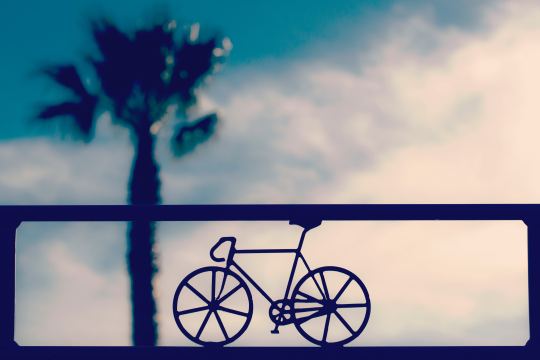
(Photo: Unsplash)
Moving Meditation
I’ve learned I prefer the slower pace of biking and walking to work much more than driving. When I bike or walk to work, once I’m out of my neighborhood, I’m on some major streets where cars are whizzing by in their AC or heated seats, with radio blasting, trying to make it thru the ‘orange’ light! That was me for most of my former driving life, so no judgement here. I was a car owner from age 17-35, so I love a good car dance and I will never turn down heated seats! However, biking and walking are organically a much slower pace. They cause me to notice the plants, the trees, the flowers I pass by daily, and watch them transform through the seasons. Biking and walking allows me to enjoy the songs of the birds and say hello to all the neighborhood pups and kittens. I’m not being sappy here, these are things that truly make me happy. I’ve even noticed how the sun rises and sets at different angles in the sky, as the seasons change, which in some deep way makes me feel more connected to All That Is. On the way home, I get to revel in some of the best views of our Arizona sunsets, as I can linger wherever I want, stop and gaze at the sky and allow myself to be mesmerized by the palette of magenta pinks and fiery oranges. Not to mention inhale the yummy wafts of dinner that swirl through the evening air in Coronado (my eclectic neighborhood!) - Italian garlic and Indian curries are the usual fare! YUM! It’s delightful! These little nuances are imperceptible to the whizzing car with blasting music. The slower pace allows me to tune into the subtler moments, cycles and patterns of life, as well as engage my senses much more, all which for me, enhance my entire experience of the day, and consequently of the seasons in my own life. It is quite literally a moving meditation.
Gratitude
So, how is the bike life going, do I still like it, is it worth it?! Yes, for many reasons! Financially, it definitely is an amazing option that I have in my present situation. But, of even more value, are the daily, small ways that this lifestyle pulls me into the present, allows me to feel Nature into my bones and tunes me into the frequency of the Elements. For me, these consequences are gifts that I did not intend and for which I am daily grateful.

(Photo: Sunset taken on a ride home from work.)
#bikelife#bicycle#meditation#nature#walking#gratitude#bikingphx#phoenixsunsets#arizonasky#azlove#slowpace#movingmeditiation#deepdive#seasons#ponderings
0 notes
Text
Heatwave Heads-Up
Guys, if you’ve heard the news there’s a heatwave coming for the majority of Australia. Minimum temps look to be low 30s, all the way up to pretty much 50 degrees celsius (or above, they can’t be certain until it happens).
-
What can you do?
>Stay hydrated. Casual reminder that many softdrinks are diuretics (make you pee more frequently), and can actively dehydrate you faster. Drink water, if possible. Have some on you, or in the car, just in case.
>Use ice cubes. In drinks, in little plastic bags as an impromptu cool brick, as something to put in your mouth to cool down, as something to put in your pets’ bowls for them to lick and cool down.
>Wear sunscreen. No matter what skin colour you have, intense UV rays provide a threat to all of us. Australia has a high rate of skin cancer under normal circumstances, don’t tempt fate. If you are in water, sweating, or working in the sun, make certain to reapply frequently.
>No Fire. Even now the Fire Warning Signs are obscenely high, do not light fires. There are fire bans in place over the weekend, check in your local area.
>Cold Bricks/Ice Blocks/Wet Towels Utilise cold bricks or ice packs to keep yourself (or the more vulnerable) cool. Wrap them in a damp towel or washer; it makes it more comfortable, and encourages animals to use them. Eat ice blocks. Basic zooper doopers are great, but if you have young children there are electrolyte-rich ice blocks you can get for kids/elderly (most chemists have them). Never underestimate the power of a wet towel, or a wet washer that’s been in the freezer for five minutes. You can make impromptu ice bricks with soft drink bottles (see link below re: Keeping Pets Cool).
>Use the Aircon Wisely Some states are expressing concern about the utilisation of aircons and the power demand may leave homes without power (due to blackout). Keep it on 25/26 degrees, and use fans/alternate methods if you can, to keep cool. Officials have asked you not use significant power during the hot points of the day (e.g. turn off devices on standby, don’t cook the minute you get home, don’t use excess power).
>Wear appropriate attire. Slip. Slop. Slap. And All. Cover most of your skin, if you can, whilst outside; wear breathable clothing. And wear a hat. Less to burn like bacon as you commute. If you are home, no one is stopping you from being naked... just shut the shades.
>Showers/Baths Are good ways to keep yourself and/or young children cool, if you don’t have access to the pool/beach. If at the beach, please stay within th flags. If you can’t swim, don’t tempt fate and wade out too far.
>Roll down the windows before you drive. 5 minutes or so, open the doors, anything to cool the car down. If you have a windowshield, use it. If not, just put a washer or towel on the steering wheel the night before or whenever you remember, it prevents you from burning your fingers when you go to drive out.
>Only go out if you have to, don’t travel n the middle of the day unless you really need to.
>Have your medical professional/veterinarian’s number to hand. If you are concerned, call them and ask. Doctors and Vets field a lot of ‘is this okay?/do i need to come in?’ calls everyday, and especially in summer. If you’re not sure, ask a professional. If you are concerned, call. >Covering attire To the Aussies out there who cover the majority of their bodies/wear headscarves, etc. Please be aware that the temperatures will be extreme, and take appropriate precautions, such as having water or a small handheld fan on your person. The more breathable the fabric, the better you’ll be. But, like stated above, don’t go out if you don’t have to (unless you’re heading to somewhere with aircon).
>Also, there are people who are sensitive to sudden temp changes, so if you’re moving in and out of heat/aircon, pay attention to small children, the ill and elderly. The Transition can sometimes exacerbate issues. Sounds silly, but it happens.
>If you have someone who has difficulty communicating or is non-verbal, please remember to pay closer attention during high temperatures as it may be difficult for them to express to you that they are experiencing distress. Signs of heatstroke and dehydration may not always be overt, until serious, which is the time when they will have the most difficulty communicating
>Excessive sweating can lead to dehydration, so make sure to have something that will replenish lost electrolytes and give you energy. Try to eat regularly, extreme heat can make you feel too lethargic to eat, but it’s important to have at least something small.
>If anyone is new to Australia, or visiting, and thinks we’re being ridiculous... Listen, we’ve survived 50+ degree days before. It’s not a joke. It’s going to get would-prefer-death hot in some places and we want everyone, from the smallest joey through to the buffest roo, to make it. Prepare, pay attention, Survive.
-
Signs of Dehydration [Mild-Moderate] Dry, Sticky Mouth Sleepiness or Tiredness Dry Skin Headache Constipation Dizziness or Lightheadedness Few/No tears when crying (important for babies) Minimal Urine (strong scent likely) Dry, cool skin Muscle Cramps [SEVERE]
Extreme Thirst Irritability & Confusion Sunken Eyes Dry Skin that doesn’t bounce back when pinched Low Blood Pressure Rapid Heartbeat Rapid Breathing No tears when Crying Fever Little/No urination (urine darker than normal) In serious cases: Delirium or unconsciousness
-
Signs of Heatstroke:
Fainting High Core Body Temperature Throbbing Headache Dizziness and Light-headedness Lack of sweating despite intense heat Red, Hot and Dry Skin Muscle weakness or cramps Nausea & Vomiting Rapid Heartbeat, which may be either Strong or Weak Rapid, Shallow Breathing Behavioural Changes such as confusion, disorientation, or staggering Seizures Uncnsciousness
-
Most at risk: Animals/Pets, Elderly, Ill, Children,Pregnant Persons, Babies, Wildlife.
-
WHAT CAN YOU DO?
>Call for medical assistance. >Sit them down on a solid surface (if safe/unlikely to faint), or get them to sit on the floor. >If someone has fainted, ‘get them up again’ is the worst thing you can do. As my Parental Unit always says, “You can’t fall further than the ground, just make them safe where they fell”. >Try to cool them down. >Offer water. >Listen to anything and everything that the emergency services person on the line tells you to do.
-
>For pets, (see additional post for signs, symptoms, prevention), call your vet immediately and let them know you believe your furry family member is dehydrated or has heat stress. >For clearly dehydrated/heatstressed wildlife, call the RSPCA (1300 ANIMALS/1300 264 625) to let them know you have injured/ill wildlife and they can dispatch assistance. >You CAN leave water out for them, or even put ice cubes out where they can be lickable; depends on the level of trust you av with your backyard buddies. >Some wildlife will be amenable to having water offered to them directly while distressed (e.g. you may have seen photos of desperate koalas and wallabies drinking out of water bottles being offered by humans); so if it is safe, try that course of action. But remember that animals that are disorientated, ill or injured will be defensive and flighty.
>If you have something that they are likely to take shelter under/shade under, then leave the water there. Please remember not to bother the animals there, no matter how much you want to take pics or ‘try to pet them’...
-
Additionally: Post on How to Keep Pets & Wildlife Cool
-
Prepare. Be Aware. Survive.
She’ll Be Right isn’t an option when it comes to Extreme heat, mates.
704 notes
·
View notes
Text
Panama in the pandemic
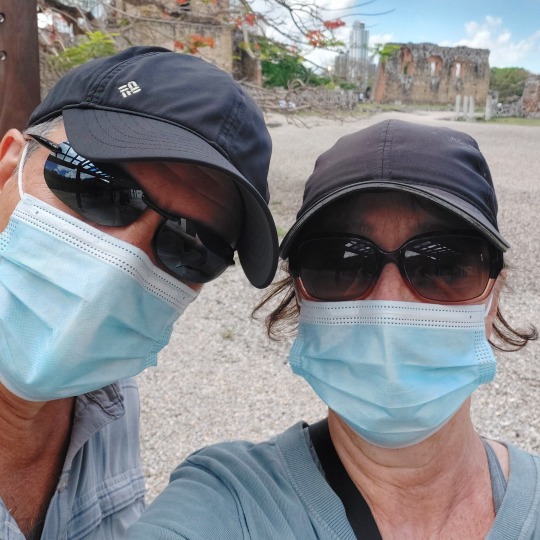
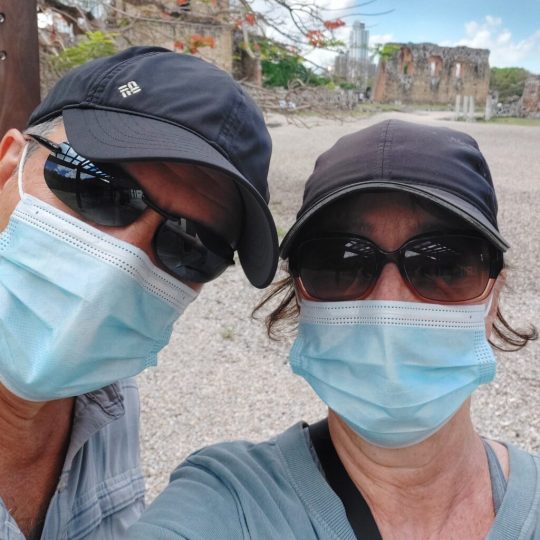
It's weird that we have spent most of our time in Panama in a pandemic. But, we've been extremely lucky to be safe, healthy and employed. The vaccine is slower to roll out here than in the U.S. but while we wait (me more impatiently then Jeff) I'm reflecting at how much different things are now vs. a year ago. Panama had one of the strictest quarantines in the world. The below chart (taken from a site called Our World in Data https://ourworldindata.org/) shows the level of restrictions compared to the US.

For a week there in November we were living life free and easy compared to the US.
At first it seemed like no big deal
It started out the same here as everywhere. We thought it would be over in two weeks. Here we are learning the pool was closed (or auditioning for most overly dramatic expats ever). Imagine our faces if we had known it would be a bit longer than two weeks.

Alas, the pool has closed. We are tortured.
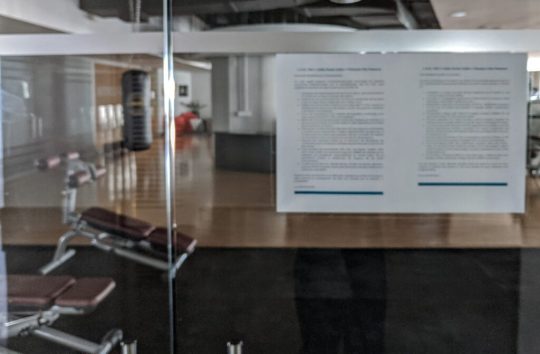
Not sure why I cared about the gym closing since I never used it. When they started boarding up the stores we got a little nervous. Would there be looting? Riots? Toilet paper shortage?
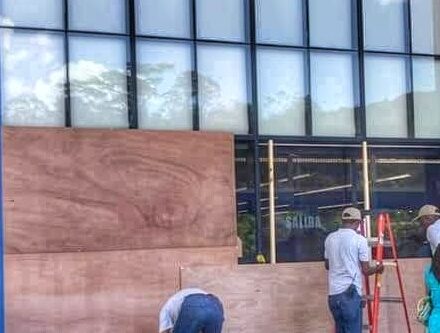
There weren't any riots, looting, or even toilet paper shortages.
And then came Women and Men days
When they divided the week up into women and men days we became concerned. When we found out you could only go out for two assigned hours on your day we freaked out.

Wait what? Based on the last digit of my passport and being female, I had 8:30-10:30 M,W,F. Jeff had 7:30-9:30 Tue and Thur only. For once, being a woman came with some advantages. Men having less hours than women is probably whey they expected rioting. What happened if you were transgender or non binary? Sadly, you might be harassed or arrested. What happened if you were out at the wrong time or day? You could be fined or even arrested. How did they know if you were out at the wrong time? There were police checking your documents to make sure it was the correct time. If you went to a grocery store at the wrong time they would not let you inside. But if living in another country teaches you anything, it’s to be adaptable. We started having our food delivered online.
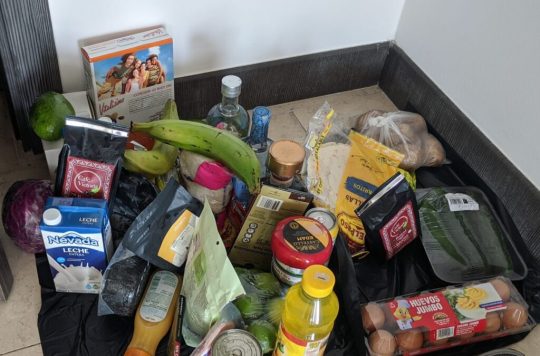
Remember when we washed all our food before it entered the house? Still never quite figured out how to wash a pineapple. Since we were only allowed to go grocery shopping during our two hours on our day/times out I walked to the grocery store, the far away grocery store.

Remember when we thought this was a good idea? Maybe I can just wash this elevator while I'm in it since I'm already wearing rubber gloves.
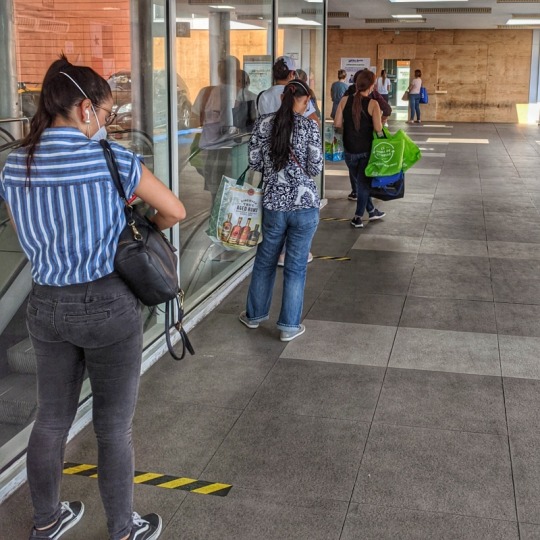
Hello ladies mind if I get in line with you?

Going into a store required a mask, temp check and a foot bath. Note these are not my feet or legs but I do wish I owned these leggings.
We thought we'd get fit during the pandemic
In our spare time, which was all the hours, we climbed up and down the fire escape.
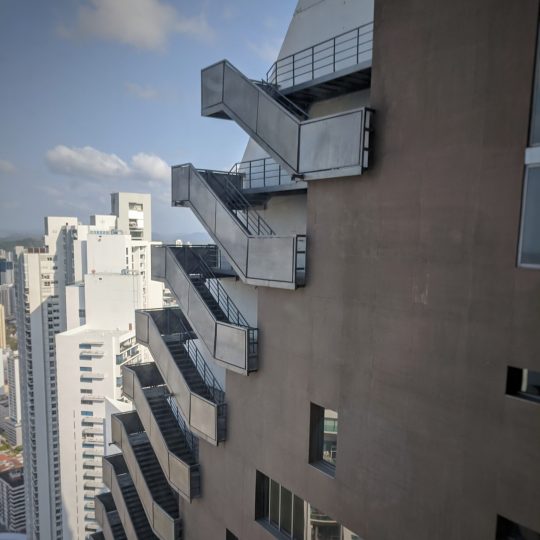

Then an email went out to the entire building saying no one was allowed out on the fire escape unless it was a declared emergency. No problem, we had long hallways. a parking garage and balcony .
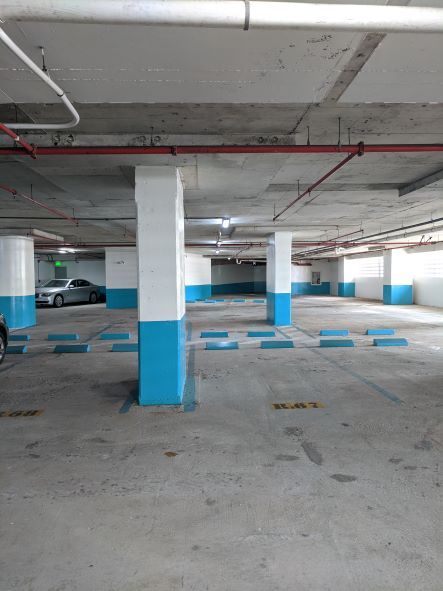

Who wouldn't want to workout in a parking garage in 90 degree heat? And it was only 38 times back and forth on the balcony to equal a mile. I even bought a Door Gym.
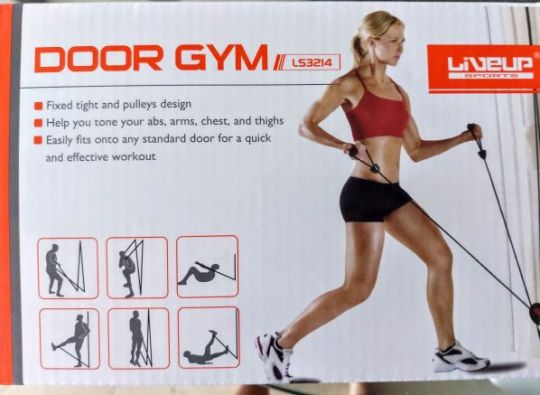
This worked great we used it every day and got super fit. hahahaha. Not. I tried it once, was afraid I'd break the door and poke an eye out.
We only went a little nutty
Soon we found that exercise was overrated. There is some research that shows that exercise helps to alliviate stress, but we seemed to be just fine.

What do you mean I shouldn't turn my video on during a work zoom call?.
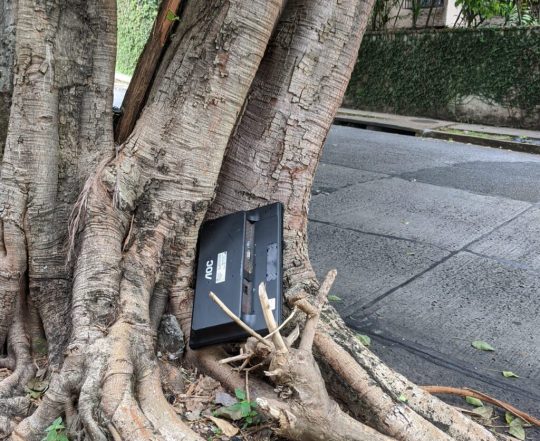
I did not throw this monitor at this tree, only because I didn't have a computer monitor.

Do you think that bird on the balcony will be my friend?
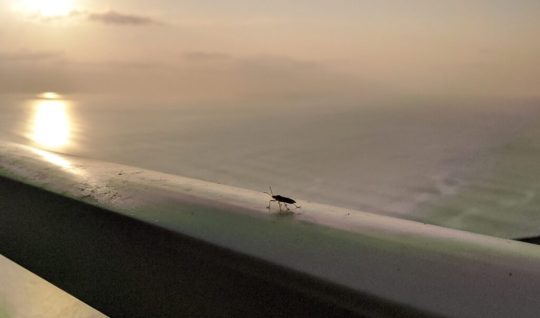
This bug will be my new pet. I shall name him Clyde and cherish him forever. Buying these highlighters were probaby the highlight of the pandemic for me (excuse the pun). I spent an entire day doing a photo shoot with them.
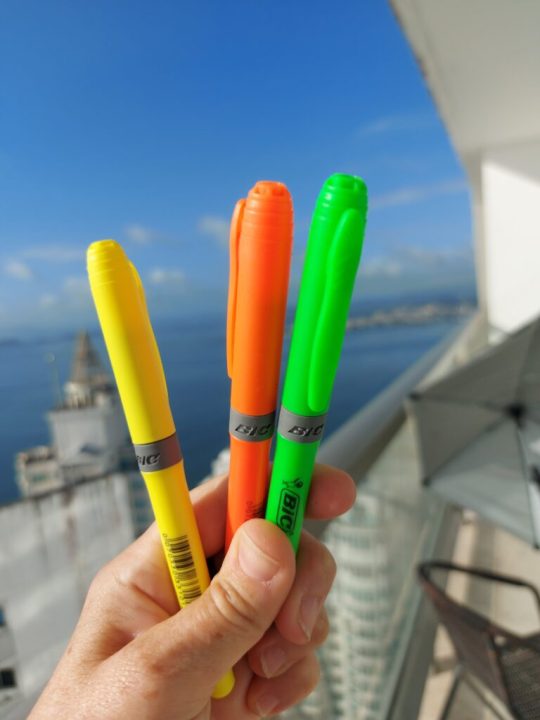
They're so pretty.
Alcohol was completely banned
Worst than not beling allowed out of our apartment building? Alcohol sales were banned throughout the country. Yes, banned! Why? We think they wanted people to spend money on food not booze, and it would help keep people from getting drunk and breaking the quarantine laws.

Shoplifting never seemed so appealing. After our wine and gin was depleted we had to go into stealth mode. The local mini mart still had a healthy stock of liquor. Sure they had signs saying they couldn’t sell it. But Jeff is nice and good at Spanish. He talked them into selling us a secret bottle or two. In theory you were not even allowed to drink alcohol in your own home.


That was one law we had to break.
We had friends to break the alcohol law with
Lucky for us, the only friends we have in the entire country, happen to live in our building. We could hang out with them without breaking quarantine.

Rolf and Samuel were friends before the pandemic, but in the last year they have become like family. We have spend countless evenings, holidays, and many bottles of illegally purchased alcohol together.


Can you see all my teeth or should I smile more?

Their balcony is way windier than ours. Not only are they great people they are fantastic cooks and hosts.
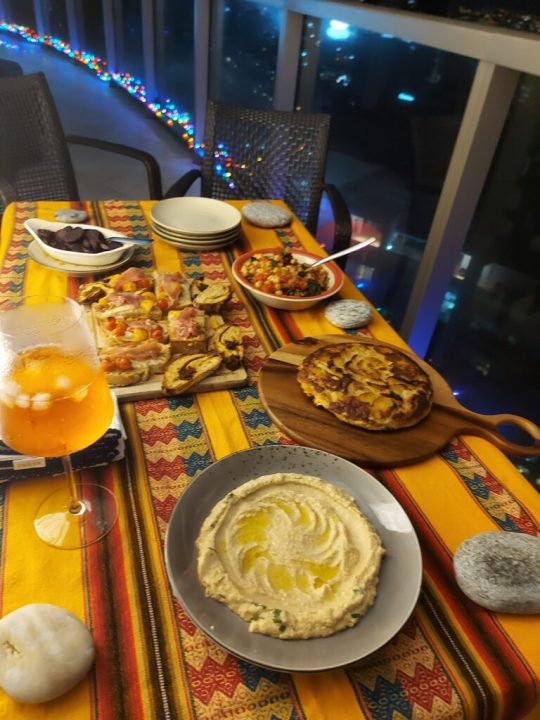
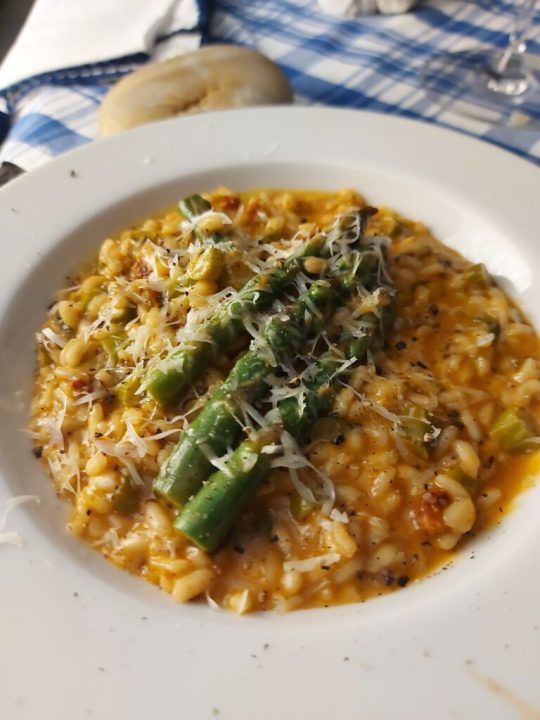
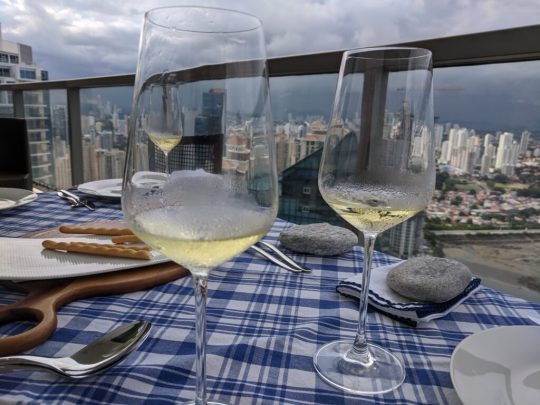
Dinner at their apartment includes champagne, beautiful table settings and professionally plated food. Dinner at our apartment is a more informal affair.

Oh wait you need a fork? Yeah we don't have any clean ones. As things got better, parks opened up. I was able to walk out here on women's day. I was also lucky that my assigned time was early in the morning before work started and before it got too hot outside.
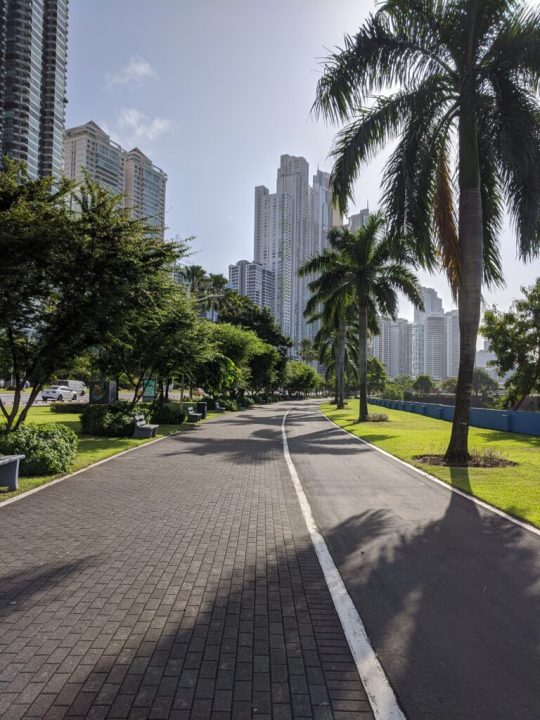
Finally, after months of only being outside seperately, they lifted men and women days and we could venture out together.
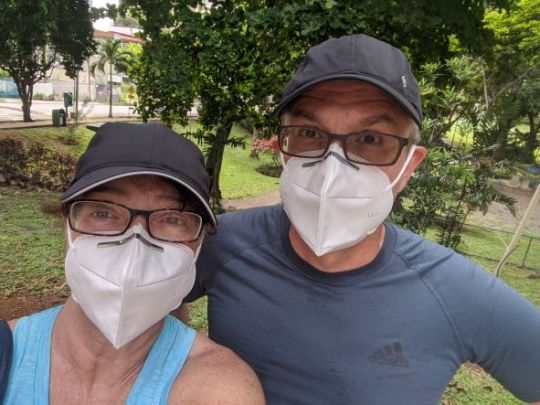
Shery: Why are you standing so close to me? Jeff: Really? Another selfie? So yes, we came to Panama and then were in lockdown for a year. But, we've stayed healthy and employed, been able to Zoom with our family and friends, and have friends here.
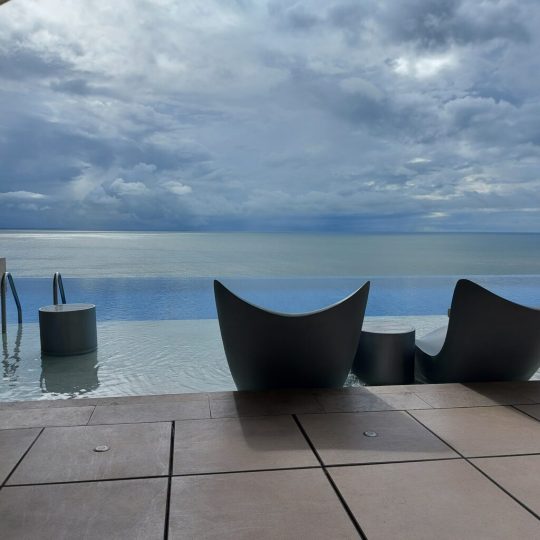
You would think I wouldn't complain now that the pool is open again and I can just sit here while I wait for the vaccine. But I do complain...a lot. Restrictions have lifted but the vaccine is slow to rollout . Currently to be eligible you have to be sixty and above.
What's next
We are venturing out slowly and safely. And to answer the question of what's next? We really don't know. Our #1 priority is to get vaccinated and see our families. After that we hope to return to Panama and do the trip we planned pre-pandemic. So we'll see. In the meantime we continue to wait for the vaccine here in Panama City

.

Jeff: Look at this view. Enjoy it and be patient. Sheryl: Hurry up with the damn vaccine already!!!!!!! Read the full article
1 note
·
View note
Text
Flying over mountains isn’t as scary (or hard) as you might think
“I shopped the Strip at Mahoney Creek only to see its windsocks voting in opposite directions.” (Julie Boatman/)
This story originally featured in the May 2020 issue of Flying Magazine.
My relationship with the mountains began on hikes with my family, camping trips up into the farthest corners of Glacier National Park that could be reached with a 7-year-old (me) and a toddling 4-year-old (my little brother) in close formation. We took what we could carry in our little packs—supplemented heavily with the resources my parents stuffed into their own.
Fast-forward to my early flight-instructing years in Colorado, where one of my greatest joys was introducing pilots to the high country—famously high-altitude airports like Leadville, Telluride and Aspen. The “real” backcountry beckoned, though, and about 15 years ago, I took a condensed, one-on-one mountain flying course with well-known backcountry instructor Lori MacNichol, through McCall Mountain Canyon Flying Seminars. The flights I made there cemented my love for the high country and, more so than that, provided me with a skill set that could be applied to much of my everyday flying.
Indeed, these lessons that the mountains bring to us know no gender, age or aviation background. So, when Christina Tindle from WomanWise Aviation Adventures dropped me a note on Twitter, asking my interest in joining them for an upcoming seminar in Cascade, Idaho, I was intrigued by two things: how flying with like-minded pilots would enhance my experience (or detract from it) and how much I would recall from my previous time flying into the Idaho wilderness.
A psychologist and counselor by occupation—and backcountry pilot—Tindle launched a series of seminars in 2011 with a fly-in to Smiley Creek, Idaho. In 2019, she conducted four events in Idaho and Colorado, focusing on backcountry flying but also touching on other areas of flight based on the requests of participants, including upset and recovery training, aerobatics, floatplane flying, and primary tailwheel instruction.
“These lessons the mountains bring to us know no gender, age or aviation background. ” (Julie Boatman/)
Setting goals
I knew this aviation seminar would be different when Tindle sent me a pre-event registration packet that included an overview with the quote, “If the shoe fits, you’ll dance a lot longer.” While the questionnaire accompanying the notes asked me to list standard items such as my flight time and recency of experience—and relative comfort flying in the backcountry—it also asked an open-ended question, “What do you want from your experience at WWAA?”
You could respond with a simple answer, or you could dive in more philosophically. Given that the registration form also noted that we would be formulating Life Flight plans, the intention with the question was clearly broader than simply probing our need to improve our confined-airstrip-landing skills.
Because I would be a speaker at the seminar, giving a presentation on coping with life’s “go-arounds” (often mistakenly referred to as “failures”), I left my answer generic, knowing I’d address the very topic I wanted to work on—extrapolating the confidence I’ve often gained from flying into my life on the ground—in my talk with the group.
A careful study of the terrain and airport information before you fly is critical—but takes on even more significance in the mountains. (Julie Boatman/)
Preparation and planning
Weather in Cascade in the third week of September can offer up anything from summer-like temps and density-altitude concerns to drizzly clouds and mountain-obscuring ceilings—or even a blizzard. I scheduled two days of instruction according to the forecast, knowing I could add an aerobatic flight or some tailwheel practice as the actual conditions allowed.
To balance the flying time, Tindle scheduled briefings from the instructor corps in the afternoons and evenings. For example, in one evening, Bob Del Valle of Hallo Flight Training (based in Priest River, Idaho) covered key concepts, such as engine failure after takeoff and accelerated stalls, as well as decision-making skills tuned to the environment in which we’d fly.
I spent my first day of flying with Fred Williams, an instructor who splits his time between Cascade and Reno, Nevada. He offered up his Kitfox with large-format tires for our flying—an airplane I’d flown only briefly with a friend in the more urbane environs of airpark-rich Florida.
View this post on Instagram
Highlights from the “Lessons From The Mountains” appearing in May 2020 FLYING. #instaaviation #avgeek #avgeeks #explore #aviation #flying #pilots #airplanes #goflying #aviationlovers #flyingmagazine #flyingmag #pilotsofinstagram #mountainflying #backcountry #backcountryflying #idahoflying #flyidaho #kitfox
A post shared by Flying Magazine (@flyingmagazine) on May 6, 2020 at 10:28am PDT
We briefed the flights in detail before launching, with a careful look at the airport diagrams and sectional charts, as well as the beta put together on each approach by a long list of experienced (and mostly successful) mountain pilots before us. Williams quizzed me on general concepts such as performance and high-country macro- and microweather to determine my background and review any areas I needed to address. Because my previous time flying in the true backcountry had been more than a decade ago (and different from flying at high-elevation yet improved airports in the Mountain West such as Santa Fe, New Mexico, or Steamboat Springs, Colorado), there was much ground to cover.
Understanding performance is paramount to mountain ops—whether it involves a new-to-you airplane, as was the Kitfox for me, or an old friend like the Cessna 182, which I would fly on day two. I looked forward to flying a made-for-the-mountains machine like Williams’ Kitfox, which has a 115 hp turbocharged Rotax 914 UL engine up front coupled with a Garmin G3X Touch integrated flight deck in the panel, about $150,000 as equipped. As a special light-sport aircraft, the Kitfox in this configuration keeps training costs reasonable while, at the same time, offering some of the latest technology and safety features.
We knew wind would likely become a factor after lunch—very common when flying in the mountains, regardless of the season—so we planned to keep a watchful eye on the wind vector shown on the G3X as we crossed passes on our way out and back.
“A Canyon Turn takes advantage of the fact that reducing airspeed decreases the radius of your turn.” (Julie Boatman/)
The practice area
Once briefed, we launched into blue and headed east to the practice area, in the valley hosting the Landmark, Idaho, airstrip (0U0). Before reaching the airport vicinity, Williams had me practice canyon turns in the broad valley, slowing down bit by bit to tighten them up. A canyon turn takes advantage of the fact that reducing your airspeed decreases the radius of your turn. If you execute a turn using a 30-degree bank at a near-cruise, density-altitude-adjusted groundspeed of 120 knots, the radius of your turn is 2,215 feet. At a speed near VA for many single-engine airplanes—say, 90 knots—you take up a lot less real estate, at 1,246 feet. If you can safely reduce your speed to 60 knots, that figure drops to 553 feet, and you can just about execute a 180-degree turn in 1,100 feet laterally. Use of flaps can help maintain a slower speed—making a huge difference when you contemplate a course reversal below canyon walls.
But those take practice to execute well. In Del Valle’s briefing, he had gone over the increased stall speed inherent with a turn of increased bank. With a bank angle of zero, let’s say your airplane has a stall speed (VS) of 60 knots. At 30 degrees of bank, that speed increases 10 percent to 66 knots; at 45 degrees of bank, it’s up to 72 knots. Because the Kitfox’s VS was much lower than 60 knots—try 49 mph with no flaps—we had a lot of room to play with, but still the smaller the bank, the less the chance we’d run into accelerated-stall territory. A good canyon turn is a balance of these aspects.
Surveying the strip—what some pilots call “shopping,” a term I first heard from MacNichol 15 years ago and in common usage among Idaho pilots—takes practice, too. Flying an extra traffic pattern gives you time to ferret out the details. Sometimes, you have to do this a lot higher than a standard traffic-pattern altitude, and you might not have sight of the strip during the approach until you’re on short final.
At Landmark, we had a relatively wide-open valley in which to maneuver as we gauged the status of its 4,000-foot-long, 100-foot-wide surface. As we worked through the day, flying to Indian Creek (S81) and Thomas Creek (2U8), we would need progressively more-inventive ways to survey the landing site before making our approach. On day two in the 182, we would do the same with instructor Stacey Burdell, scoping the scene at Stanley (2U7), Smiley Creek (U87), Idaho City (U98) and Garden Valley (U88), consecutively.
Checking the actual weather against the forecast also proved most important, especially because of the winds at ridge-top level contradicting those at the surface—or even at the ends of the same runway. With Williams on day one, I shopped the strip at Mahoney Creek (0U3) only to see its windsocks voting in opposite directions. As much as I wanted to land there and tag another new strip in my logbook, we left it for another day. We bounced around enough on the way back to Cascade (U70) to validate my choice.
Most visitors to the Frank Church River of No Return Wilderness float or hike in, but flying yourself offers an unmatched perspective. (Julie Boatman/)
A stabilized approach
If you have this image of a backcountry pilot making crazy maneuvers to “make it” to a landing, dispel them from your mind right now. If you have any sense, you won’t accept anything less than a stabilized approach—and you’ll bail out early if you can’t maintain your airspeed and sight picture.
That said, the stabilized approach to a backcountry strip looks a little different than the one you might use in normal ops. This stems directly from the fact many mountain strips are one-way-in runways and have a “point of no return,” after which you must make the landing. A super-low-speed, power-off, short-field approach doesn’t offer the same margins for adjustment at the last minute that the backcountry approach does.
We practiced at Landmark—which has no point of no return because of its position in the valley—setting up a steep, low-power descent at a moderate rate, with full flaps in the Kitfox (think 30 degrees if you were flying a Cessna 172) and a speed at 1.2 to 1.3 times VSO, which correlates to about 55 mph indicated in the Kitfox. This configuration offers the ability to use more or less power if needed and modify the descent rate to avoid landing short—or long.
The key is to lock this in well before you reach your predetermined go-around point. If you don’t have the configuration in place and stable, you need to execute the go-around before that point of no return, or you risk everything. One of the approaches on day two was not well-stabilized, at Garden City, and it drove home the necessity of staying diligent about this practice—and being locked and loaded to go around if you’re too high and too fast at the key position, rather than forcing the approach.
Instructors Fred Williams and Danielle Maniere have fun in the Kitfox. (Julie Boatman/)
Life lessons
There’s an aspect of facing and conquering the unknown that carries over into the rest of your experience. The mountains are personal to me, and returning to them at a perfect time in my life, when I needed a shot of self-confidence, made all the difference in the world.
As weather drew in on day three, we bagged the airport activities for a hike into a nearby hot springs as the snow fell around us. The camaraderie was real as we navigated slippery rocks, and it would continue on in the aviation friendships I made that week. Our Plan B was just fine—and executing it reiterated the joy of taking advantage of life’s sharp turns. A disappointment became an opportunity to enjoy the natural beauty of a place we could access through general aviation. That’s another lesson that feels particularly poignant now as we face uncertainties ahead in life.
On the last evening of the seminar, the group encapsulated our plans for the coming days, weeks and months into concrete goals. Mine was simple: to keep flying. To keep exploring new places only an airplane can reach. To tap into that well of confidence-building stuff that only learning to fly has provided me. And that too is something every pilot can take away.
An approach into Garden Valley. (Julie Boatman/)
Mountain skills you can use every day
Pay attention to micrometeorology—and understand how fast the weather can change. In both the mountains and the lowlands, the environment immediately surrounding an airport can funnel winds and generate up- and downdrafts worthy of note, along with localized clouds and reduced visibility.
A stabilized approach is a safe approach. While you might use a different technique for your approach to a “normal” runway, setting a configuration and rate of descent to have in place by the time you’re at 500 feet agl—or higher—will stack the deck in your favor for a better landing.
Practice and plan for a go-around every time. In the backcountry, your go-around decision point might not be over the runway, or even on short final. Committing to a go-around plan, and knowing when you’ll trigger it, is vital. This holds true with every single landing you attempt.
The go/no-go decision continues throughout the flight. While you may consider the flight launched once you’re airborne, you’re always in a position to return to the place you just left, divert, or come up with some alternative to the plan you had in mind. This mental flexibility may very well save your life someday.
Take the right equipment. Save room (and weight) for a well-stocked flight bag—one that holds an extra layer of clothing, a hat, a first-aid kit, food and water, and other emergency supplies. Landing out, even in the flatlands, can leave you far from assistance.
Required reading
Two books guided my research, and a host of content online supports the topics they cover.
If there’s a primary textbook for flying in the high country, Mountain, Canyon, and Backcountry Flying by Amy L. Hoover and R.K. “Dick” Williams is it. Hoover has been flying the Idaho backcountry since 1989 and started teaching mountain flying in 1992 while working as a backcountry air-taxi pilot. She’s an original co-founder of McCall Mountain Canyon Flying Seminars. For the book she teamed up with pilot legend and author Dick Williams, who started training pilots in the backcountry in 1985. It’s available through Aviation Supplies and Academics.
For those who want their mountain flying in concise form, seek out a copy of Mountain Flying by Sparky Imeson, published in 1987 by Airguide Publications. Imeson, who ironically died in a March 2009 accident involving his Cessna 180 in the mountains, founded Imeson Aviation in 1968 at the Jackson Hole Airport in Wyoming. His wisdom—and the website, mountainflying.com—lives on, disseminating his vast knowledge of the techniques and decision-making critical to flying safely in the backcountry.
More aviation adventures
Tindle plans more WomanWise Aviation Adventures for 2020, though at press time they remain in flux because of general travel concerns in the spring, which we all hope to have dissipate by summer. Tindle said in March, “[I’m planning] September 6 to 10 in Steamboat Springs, Colorado, for high-mountain flying, aerobatics and spin [training], and soaring, which is new. [Then it’s] October 25 to 29 in Moab, Utah, for backcountry flying, aerobatics and spin [training], and ballooning—also new.”
Check womanwiseaviationadventures.com for more details.
Also, look to Fred Williams’ Adventure Flying LLC for the wide range of flight training he provides in Cascade, Idaho, and Reno, Nevada, both in the Kitfox or in the aircraft you bring (contact Williams for details via advflying.com). Bob Del Valle offers instruction in Sandpoint, Idaho, as well as around Montana and Washington (halloflighttraining.com). Sam Davis offers instruction in aerobatics, as well as upset prevention and recovery, in the Heber City, Utah, area through Pilot Makers Advanced Flight Academy (pilotmakers.com).
0 notes